#but i saw these two frescoes earlier this year
Explore tagged Tumblr posts
Text


fernando botero | chiesa della misericordia | pietrasanta
#rip#fernando botero#art#painting#i've never cared much about botero's paintings#but i saw these two frescoes earlier this year#and they were absolutely stunning#still in love with them#pietrasanta#italia
351 notes
·
View notes
Text
Why Thor: Ragnarok is remake and doesn't fit to other movies of Thor

I will talking only about chronology in this post. Hela shows ''true history'' of Asgard. Well, but we have one problem. We watched Thor and Thor: Dark World. This both movies are the denial of Hela's words.
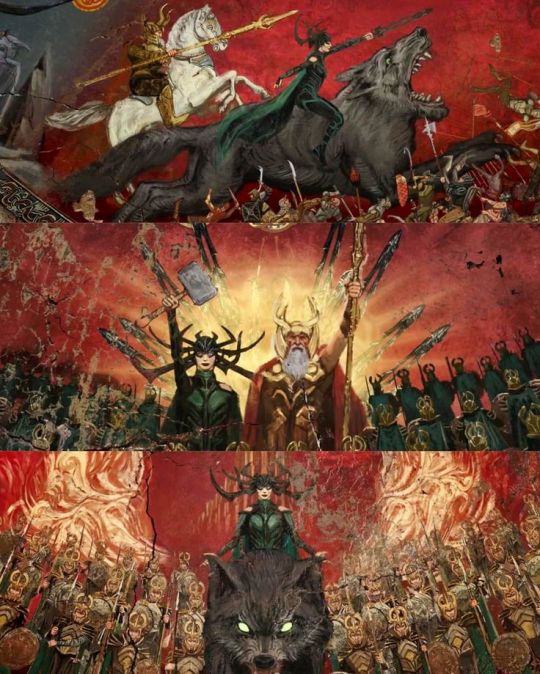
The frescoes show the winning couple. Odin and his daughter conquering the world. Look at Odin. A white, senile beard… interesting… because we saw what Odin looked like over a thousand years earlier at the time of Loki's birth.
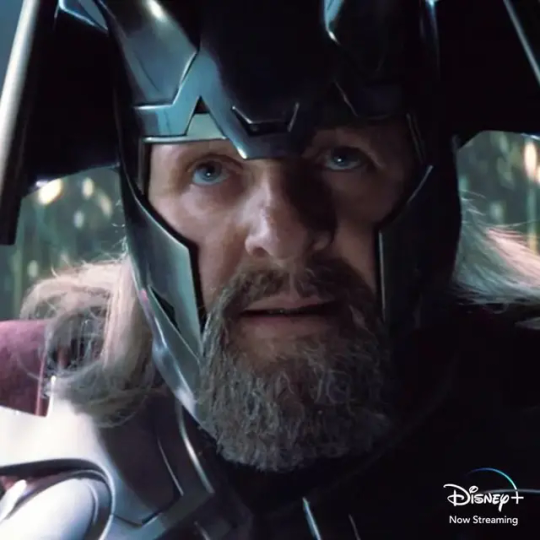
Here later with both sons.
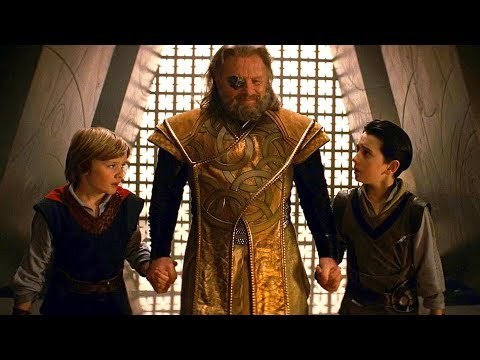
And here as King of Asgard when Thor and Loki are grown men.

The war with Jotunheim was in 965 AD.
And Odin looked completely different at that time than he did in 2011-2013.
Next thing… is the case of Borr and the war with Malekith.
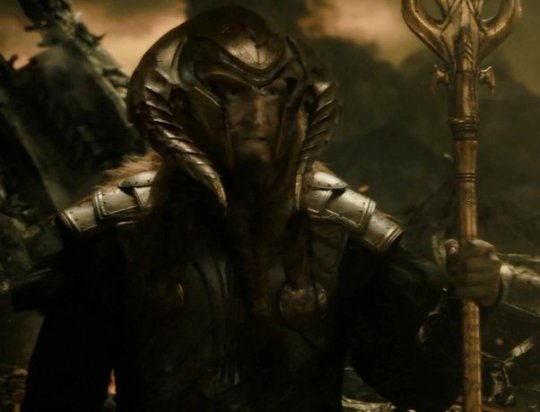
5,000 thousand years ago, Borr was still the king of Asgard and fought against the Dark Elves. Interesting thing, his heir is not with him. Odin is not present during this key battle. He seems to truly believe that his father defeated Malekith.
Why isn't Odin present during this battle? We have two options… and they are related to age. Either Odin was too young to fight battles (Asgardians do not have children during battle, Mr. Taika Waititi! If Loki saw that scene with his mother, he would tear your head off!) or he was a very young man who was just old enough to be regent during his father's absence… which would make him roughly the age of Thor and Loki in Thor (2011).
However, both situations quite exclude the possibility of Odin being an old man with an unstoppable desire for power and an adult daughter.
Even assuming that Borr died quickly after this battle and Odin already had a teenage/adolescent daughter… that still doesn't fill the gaps. Because Odin was not the old man shown in the frescoes. And if he had access to the fountain of youth, he would use it again rather than allow Hela to be released?
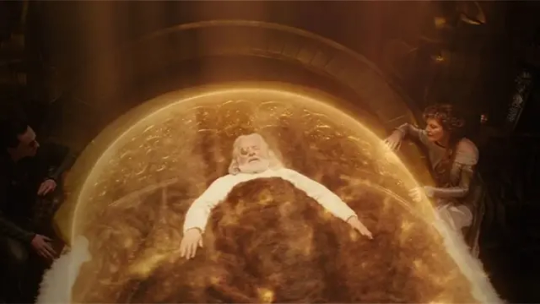
Failure to solve the problem of Hela also puts the events in Thor 1 in a strange twist. Odin actually believes that it's time for Thor to be king. Why? He put off Odinsleep, Frigga really thought he might not wake up from this. He probably also realized that his strength was weakening. And… he didn't tell any of his sons… when I die, your bloodthirsty half-sister will suddenly appear and want to kill you? What kind of ruler does this?
My conclusion : Thor Ragnarok is remake.
We see the actual history of Asgard… up to 2015… where Age of Ultron still honors this timeline.
Overall timeline of Thor 1, Avengers, Thor Dark World, (in the meantime movies related to Avengers like Winter Soldier or Iron Man 3) and Avengers: Age of Ultron. After that, we never see any further events. I would also like to point out that Thanos in Guardians of Galaxy and Thanos from Infinity War are two different characters. The last time we see Thanos from Guardians of Galaxy is in the scene with the gauntlet at the end of Age of Ultron. Thanos in Infinity War is nothing like the previous Thanos.
Well, Thor is probably still looking for those stones, and Loki is preparing a surprise for Thanos in their universe.
The further timeline, starting with Ragnarok, has completely different events and one could even say a different universe.
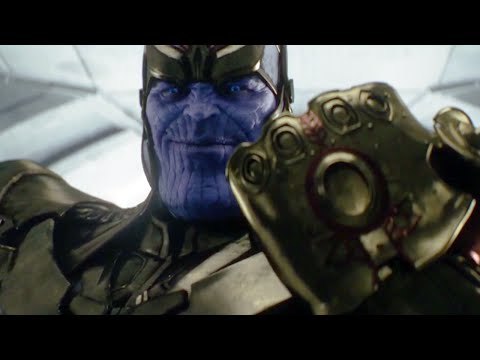
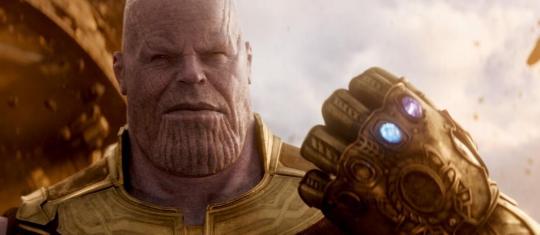
#mcu#anti ragnarok#loki odinson#loki#loki of asgard#thor the dark world#thor 2011#thor ragnarok#meta analysis#mcu meta#mcu critical#marvel meta#anti taika waititi
196 notes
·
View notes
Text
Chase You / Chase Me (Pt. 3)
Part 3: Remember when everything was different
Catch up here: Series Masterlist
Chapter Summary: Aislinn, Gigi and Alex find friendship in the midst of the competition. One discussion led to another, pushing Alex to take a trip down memory lane, revealing the moment in her past where she and Gabe's paths crossed for the first time.
Book/Pairing: Choices - Laws of Attraction / Gabe Ricci x MC (Alex Keating)
Words: 1.7k+
Rating/Warnings: Mature (16+) / alcohol consumption, language. Scenes/themes may trigger trauma for some, reader discretion advised.
Disclaimer: Most of the characters as well as some dialogue belong to Pixelberry. I am merely borrowing them.

Sunday, downtown New York
"Wait, can you back up for a moment," Aislinn said across Alex, who was scooping the remains of her melted banana split. Gigi was sipping her ice-cold mimosa, their brunch table full of plates with scrapes of leftovers. The sun was out and so were they, dining al fresco under the shade of a huge white parasol and the gentle breeze cooling them every now and then. It was a perfect day so far.
The trio has agreed to meet up that Sunday to discuss what went down with the Rothswell case as well as to prep for the conference Sadie had invited them to. They were on some kind of a peace pact, all of them sharing the view that pitting women against women in the corporate world is just shitty business.
Alex has enjoyed their company. They exchanged imaginary one-liners that would have made Martin frown his heart out or Beau McGraw chortle his head off. And speaking of McGraw, they all concluded that the best strategic course of action was to let Beau enjoy his moment in the sun. One day, Alex would make sure to remind him that he tried to rain on her parade.
It was a refreshing and enlightening discussion, though she will forever be traumatized with how many swears Gigi can cram in a single sentence. But the sight of a flustered Aislinn while Alex and Gigi engaged in a battle of pick-up lines with their waiter was a strong second contender.
As their drinks flowed, the conversation naturally led to rhetorical questions, now settling at why they became a lawyer. Aislinn shared first, surprisingly, stating that her knack for analysis was just a natural fit to the demands of a career in law. Gigi's answer was simple - she can leverage her eidetic memory to earn herself some serious dough, allowing her to live it up and take impromptu vacations to Bali.
Alex tried to dodge the question. She had never needed to discuss her reason of leaving pre-med behind to attend law school. It wasn't a pleasant memory, and she doubted it will ever be.
The two ladies were quick to see her attempts of evasion. But together, they finally wore her down, Alex left laughing with their shenanigans as they cornered her to tell her story. So she told them that she knew Gabe Ricci. And that it was because of him why she was a lawyer. Alex decided that revealing the truth was worth it, seeing how their jaws just dropped to the floor.
"Girl, you have to explain yourself right now," Gigi demanded, to which Aislinn seconded.
Alex snorted as she went back to skimming what was left of her dessert. "It's a boring sob story, and I don't want to turn this lovely morning into a snooze fest."
"We're not going anywhere, right Gi?" Aislinn turned to Gigi beside her, who nodded whilst sipping another glass of cocktail.
"Fine, but only if you swear this won't leave this table," she said. The two held up their hands invoking a half-smiling Alex, sensing nothing but sincerity. So she drank down her glass of bloody mary and took a deep breath, composing her tale.
"Buckle up, ladies, you're in for a ride."
**
10 years ago, in a town near Boston
Alessandra Keating had never felt more alone than she did that day.
They said she needed to just move forward. But how can she, when every day since the crash, she felt nothing but emptiness? How can she feel alright, when the only life that she knew was suddenly taken away from her?
It wasn't long before she found out that the car accident was caused by someone being reckless, by someone who thought they were above the law. Then, she imploded. No way could she let her parent's deaths be forgotten. No fucking way.
For the past three years, she invested all of herself into this endeavor. Researching, studying, choosing the right counsel, even raising funds. It was what kept her breathing, what gave her purpose. Ultimately, it was what kept her sane.
From filing the lawsuit to attending mediations, to numerous settlement meetings and colliding with every legal roadblock possible - Alex made sure to see them through. Only for everything to be decided that day - the bench trial.
One sweltering summer morning in her hometown's courthouse, Alex sat on the side of the plaintiff, with her long brunette hair tangled in waves. She let her senses wander, taking in the dark wooden panels and pews, her sense of smell invaded by the scent of old mahogany. She sealed her lips into silence, hiding her nerves by straightening the bargain khaki suit that she borrowed.
She barely held it in as her eyes travelled to the table beside them, catching a glimpse of the man that caused her immeasurable pain. With jet black hair and looking as young as her, he sat with an almost mocking expression. He was wearing a crisper set of suit, creating an illusion of trustworthiness that Alex can easily see through.
Maximilian K. Cornell. The green-eyed teenager who swerved his sports car onto the same slippery road Alex and her parents were passing through. The very same boy who got out unharmed, but left Alex's family to die in the snow. Her opponent was a slithery snake who managed to screw the justice system so many times over, just because his parents had the grease to do so.
But after the crash, the town decided they can no longer turn the other cheek. Alex's decision to sue was propelled by the support of the countless friends and families whom her parents have helped in their hour of need. But that still proved not enough.
Her mind whirled back to the proceedings, and to how every strategy, every plan of attack was being thrown out. With every whip from the defense, she started to grow impatient. As another traffic expert from her camp was dismissed, Alex just snapped inside. She leaned to Mr. Leroy, a withering man on the brink of retirement who was her lawyer, asking for them to convene outside.
"I'm sorry Mr. Leroy, but your strategies were just scrutinized and torn into pieces," Alex said in a low voice the moment they stepped out into the hallway.
"Alex, I am doing my best here. We clearly don't have the upper hand, lacking the incriminating evidence that we need," the man replied, exasperated.
"Have we dug up his previous records? I mean, why on earth would he have a sealed history? Doesn't that mean something?" she continued.
She continued to dictate her litany of better-positioned moves, but even Alex knew she wasn't getting through. So she excused herself from the conversation, hoping a cup of iced coffee will somehow mitigate her frustrations.
As soon as she came back, she found Mr. Leroy convening with a much younger man in a dark navy suit. His aura screamed "big city hotshot", albeit the exhausted look in his brown eyes. Not wanting to interrupt, she held off from approaching. However, her curiosity didn't stop her from eavesdropping.
What she heard the charismatic man say was a legal precedent that would have opened the sealed records in question. And with all the mind-boggling legal jargon, that's just about what she understood.
"Gabriel Ricci? I'm looking for an attorney named Gabriel Ricci?" a female voice from a nearby window called out, which made the young man raise his head. She saw him end the conversation abruptly, where a flustered Mr. Leroy hastily thanked him. Alex took that as her queue to approach her lawyer.
"Alex, we might be able to turn things around," she heard Leroy say.
And by some miracle, things did turn around. With her lawyer using the precedent offered by the young attorney earlier, their side gained the needed momentum to tip the scales in their favor. By the end of the trial, the verdict was out - Cornell will never be able to drive another vehicle, along with paying her a hefty amount of damages and fees.
They won.
Alex had to pinch herself before the victory sunk in. When it did, she felt an immense burden lifted from her shoulders.
After a long, long time, Alex can finally breathe.
Broken free from her nightmares, she asked herself what's next? The answer came to her almost immediately. Right there and then, she decided what she wanted to be. Like that man from the courthouse, she will become a lawyer.
Fueled by this new sense of mission, she saw a future for herself. No longer held by the past, she finally was able to move forward.
Indeed, Alex became what she set out to do - a lawyer who took on hopeless, even impossible cases and won them. A lawyer her parents would be proud of.
A damn good lawyer, just like Gabriel Ricci.
**
Present Day, at a New York Penthouse
Gabe sat in his home office clad in nothing but his white bath robe, holding a worn manila folder.
Five years ago, Gabe saw this case as his opportunity to make Robbie proud. The defendant had all the parallels with his brother - a teenager, incarcerated young, where the punishment had presumed to be too harsh. He now knew it was rightfully just.
But at that time, he was blinded by passion and ambition. He wanted to prove to himself and to Sadie what he can do. Taking on this case that was practically unwinnable would give him more power, more control over the pro bono cases he wanted to take. Actually winning this though, that proved to be his fatal mistake.
Your cockiness got the better of you again, Ricci.
His mind went to Alex. That was the direction his every waking moment drifted to nowadays. Whether he liked it or not, he'd answer some other day.
He had to let her know. If he didn't, Alex would eventually find out herself. Once she discovers that he was the one who had set this man free, she would hate him.
Gabe can't bring himself to think of that happening, of losing that chance with her, or of losing Alex's trust.
Hell, I'm going to lose her entirely if she finds out.
These realizations devastated him.
But how can they both escape the looming shadows of the past unscathed? Even he couldn't figure that out.
Sighing, he rubbed his hand on his face, reeling at his lack of options. He then stood up, slamming the open folder on his desk as he turned to face the window, simmering in his own regrets. Papers slipped out to the carpeted floor, including a full-page mugshot of the defendant.
It was Maximilian Cornell.
Author's Notes: With Sadie being shady AF, I feel like we all need some dose of female friendship right? Also, this is my HC why Gabe constantly pulls away from MC, not only because of their working relationship. Did the reveal live up to the cliffhanger? Let me know in the comments! 👇👇👇
Tag list: @adiehardfan @pixelnutrookie @starryjieun @latinagiraffe @sarcastic01lily @spookycolorpeanut @ophrookie @suitfer @thegreentwin @mkatschoicesblog @made-of-roses
@choicesficwriterscreations
Thank you for your continued reading!
Want to be added or removed to the tag list? No problem - just let me know 😊. Reblogs are also much appreciated! 💕
#laws of attraction#choices laws of attraction#choices loa#laws of attraction fanfiction#choices laws of attraction fanfiction#choices fic writers creations#fics of the week#gabe ricci x mc#gabe ricci#aislinn tanaka#gigi sinclair
51 notes
·
View notes
Text
Day 7 - Domestic
The moment you feel at home is when you start decorating the house. Dean had been repeating this to Sam ever since they had officially established their headquarters in the Men of Letters bunker. First of all, he began by displaying his favorite weapons in his room: his sawed-off shotgun, the machete he had made in Purgatory, a grenade launcher, his father’s fighting knives, his first stake… Quickly, the souvenir albums had left Baby’s trunk to weigh down the drawers of his bedside table.
Sam ended up imitating him by putting his clothes in the closet first, then his computer pouch in the desk, and finally he ended up storing countless books and tapes in boxes by his bed. Dean had obviously taken over the kitchen as quickly as possible and built his famous "Dean Cave" while Sam could spend whole nights devouring every book in the library or archives.
Castiel had also inherited a room — although it was rarely occupied — and was particularly fond of the calm of the infirmary, watching over one of the two brothers when necessary. Jack, for his part, was in the only house he had ever known and cherished every wall in this underground lair.
However, everyone agreed that the refrigerator was undoubtedly their favorite part of the bunker. The Men of Letters' was not a simple American fridge with two doors, nor even a fridge with a minibar option. No, their refrigerator was absolutely gigantic, with several doors dug directly into the wall and at least two meters of metal in width.
Of course, the food gets everybody to agree —especially when Dean felt like making his own handmade burgers— but that wasn’t the only reason this family was particularly fond of the fridge. It was not so much what was in it that found grace in their eyes, but what was on it.
The first person to hang anything on it was Sam. Tired of having to repeat to his brother to buy vegetables, he had then written a precise shopping list before hanging it with a magnet on the door containing the beers, certain that Dean would fall face to face with it before the end of the day. In response, Dean had hung another post-it on a lower door saying, "Here, rabbit man."
Soon after, Jack felt confident enough to hang one of his drawings, then another. Castiel had happily added the menu of this Chinese restaurant on the outskirts of Lebanon where the Winchesters loved to order after finishing a case. Dean had pinned a few handwritten recipes and Sam was again the first to put a picture of the four of them in the library, playing board games. Months later, Dean solemnly hung his wedding announcement with Castiel below the date of their first kiss, lovingly scribbled on a piece of paper. Little by little, the fridge was filled with memories and post-it notes, a fresco of their lives spread out among the gates of the metal surface.
It was past midnight when Sam decided to have a pick-me-up to continue his search among the archives. He proceeded as usual to his reserved part of the refrigerator when a bright yellow post-it attracted his attention. He knew every photo on this fridge so well that the slightest new element was now popping into his eyes and he came closer to read what it was saying.
"I’m sorry. Can we talk?"
It was definitely Dean’s handwriting. Sam frowned, the cogs of his brain creaking in his head. He hadn’t had a fight with his brother recently, it was barely if he’d seen him for the last two days. Jack had been on vacation with Jody since the beginning of the week and Castiel had left the bunker for… oh.
Dean and Castiel had a fight five days ago. Sam had not really understood the reason for the argument, the two of them shouting at each other behind closed doors before they remained silent for hours. This was the reason why Dean had been locked up in his room since Tuesday and that Castiel only came back from time to time to wander like a lost soul before leaving for an indefinite period. This message was therefore not addressed to him, Sam realized. It was a cry for help from his brother to Castiel. Although the angel did not need to drink or eat, it was true that he particularly liked to look at the refrigerator whenever he could as a reminder of why he called this place "his home".
Sam pinched his lips and decided not to interfere. It was something between his brother and his best friend and he would be there if they asked him for support, but not before. Although troubled, Sam grabbed a beer and a few cherry tomatoes before leaving the kitchen.
To his surprise, the first post-it did not stay on the refrigerator very long. The following day he had been replaced by a note written with much more careful writing despite the austerity of the words.
"You said everything you had to say and so did I."
A cold anger sweated in Castiel’s words. Sam was still in the kitchen when Dean made his entrance, heading for the food first as usual. He was also present when his brother’s eyes fell on the note and he froze to read it in silence. A few seconds later, Dean unpinned the post-it before wrinkling it and throwing it in the trash. He returned to his room without even getting the breakfast he had come to fetch.
"I’m an idiot. Please pick up your phone." Said the following note three days later accompanied by a photo of Dean and Castiel wearing reindeer antennas for Christmas that they had celebrated with family two years earlier. Sam recognized Dean’s trembling hand behind every word.
Sam soon found himself opening the refrigerator more often than usual simply to find out how his brother and Castiel were progressing in their fight, worried about each one of them. Dean was still as silent as a tomb about it and he hadn’t seen Castiel for a week now. Whatever happened between them, it was by far the longest argument the couple has had to date.
Dean’s last note remained unanswered.
When Sam opened the fridge door one morning to take milk, the post-it had been replaced by another still written by Dean.
"Sorry Seems to Be the Hardest Word, Elton John"
Sam could not help a small smile from appearing on his face. Dean had always been more gifted with music than words, but the mere fact that he chose Elton John showed something fragile and sincere. Sam hoped Castiel would get the hint. Just below this post-it was pinned a photo of their fingers intertwined, the bright wedding rings to their fingers, as well as a large black feather.
Indeed, the next day, Dean’s note was still there, but this time accompanied by a second piece of paper with an address.
"716 E Montana Ave, 1312, Baker. Room 17. You’re the One that I Want, Grease."
Not more than an hour later, Dean had gathered his belongings and was already finding an excuse to Sam when this one cut him off. They exchanged a look which they alone knew the secret before Dean nodded and fondly patted his shoulder. The next minute, the Impala’s engine was growling in the garage before moving away, leaving Sam free to go and have breakfast with Jack in the kitchen.
When Dean returned two days later, it was with Castiel next to him and a weight off their shoulders. Sam sent them a simple, gentle smile before going to hug his brother and Castiel. When he got up to bring them beers, he noticed that the post-its had not left the refrigerator. However, no one ever removed them afterwards.
The family simply added other memories as life slowly resumed in the bunker.
* * * @winchester-reload Hi! Here’s a short one for today with my favorite couple. Please, let me know if you enjoyed it!
You can find the whole series on Ao3
Tag list /!\ PLEASE TELL ME IF YOU WANT TO BE ADD TO (or removed from) THE TAG LIST so you won’t miss any updates.
@misha-moose-dean-burger-lover @styggtroll @thanks-tacos @petrichoravellichor @iamcharliebradburylevelperfect @ladywaywarddsc @hellfire37 @destiel-221b-sabriel @aloha-cowgirl @destielhoneybee @dysfunctional-destiel @ozonecologne @doofcas @castielrisingabove @zoerayne2426 @tibbinswrites @vicmc624 @thegirlofstarlight @berrieseveryday @staycejo1 @certaindeanwinchesterforcastiel @bab-spnfamily @lo-mindpalace
#suptober20#day 7#Destiel#suptober2020#suptober#inkotber2020#Inktober#supernatural#Supernatural fanfic#supernatural fanfiction#Destiel fanfic#destiel fanfiction#established destiel#dean x castiel#deancas#casdean#married dean and castiel#domestic relation#supportive sam winchester#sam winchester#jack kline#sam pov#emotionally hurt dean#emotionally hurt castiel#making up#emotional h/c#destiel hurt comfort#light angst#happy ending
69 notes
·
View notes
Note
17, 21, and 24 for the OTP ask? 😁
Well, hello, friend! I shall answer for that is DUTY! >:D
17. What senses (sights, smells, feelings, etc). remind them of each other?
I did answer this one in another ask, but I can think of a few more to share! (I got so much for these two, don't worry~)
So, another thing that reminds Fane of Solas is any kind of painting, namely frescos. Surprise, surprise! But the reasoning is mainly because Fane used to dream of frescos painted in a temple, one he always finds himself traversing in his dreams in the earlier years of his life. The style was nostalgic, impeccable, as if the hand that had held the brush was fixated on getting every line, every detail, every color, and every proportion just right. The paintings were like little anecdotes, way points trying to guide him in a direction with paint and plaster, but the story was always left unfinished, and it isn't until all the memories flood back that Fane realizes who was the artist of his dreams. *winks*
Now, I'm not usually one for 'smell' references, but oddly enough, Solas is reminded of Fane through one. Namely, chamomile. This was something I thought of one day when I was fighting with a headache and I was just watching a Twitch stream, and I was like, "Chamomile is a natural stress reliever. Fane doesn't like tea, but there are bath oils and incenses infused with chamomile, right? He would definitely be given that by someone or maybe even takes initiative to get it himself." Thus, the headcanon was established! Fane smells like chamomile, and Solas can't help but smile when he smells it from another source, knowing that his dragon is trying to help himself in some way.
21. How have they changed each other for the better/for the worse?
So, there's a little bit of A and little bit of B for this question. There has indelibly been a positive influence on both Fane and Solas due to each other. Basically, it all stems from pre-Inquisition, aka Elvhenan/Arlathan.
Fane, as a dragon, was inherently tasked with observing elvenkind, watching the flow of which they progressed and if their machinations benefited the world in which they lived. Each dragon had this inherent task, albeit in different ways. Dragons that lived in arid regions were tasked with controlling the sandscape, preserving the ancient temples by covering them with said sand, making inaccessible areas accessible for wildlife, so on, so forth.
Fane, and the others of his specific kin, not only watched the Elvhen, they guided them, but only if it was deemed necessary. White dragons could not want for anything beyond what the world needed, and their powers of absorbing, reflecting, and understanding emotions was what made them highly sought after by the Evanuris. When the Evanuris began enslaving elves, they began enslaving dragons, too. And this is around the time Solas and Fane met; when Fane was the last of his white kin. Fane had gone into recluse, hiding; he turned his back on those who were suffering because he couldn't bear to see them be subjected to magic bending and breaking their minds, turning their eyes grey where they were otherwise a multitude of colors. Solas found him through a curious venture as we all know the dear wolf is prone to curiosity.
Their beginnings were rough. Fane tried multiple, multiple times to kill Solas. He saw him as no different than those who had thus far enslaved his kin. He held anger, rage, resentment, and pride, which warped his nature of calm observation and cool acceptance to preemptive prejudice and scornful indifference. Fane stopped caring; about everything. Solas reached out to him, wanted to help him, and for the sake of keeping things somewhat short, they grew close after constant revisits and...silence. Solas allowed Fane to watch him, learn about him, read his eyes, and in turn, Fane began to open up, rediscover his original nature, and learn about another side from a more personal view. Solas taught Fane that nothing can change or return to what they had been unless he tried, and he did, even though it ended poorly. And even though it takes him twenty-four years and a lot of hardship, Fane finally remembers that important lesson and he's forever grateful, even as they walk onto the same stage that burned before.
Now, Fane has helped Solas do something we all know the dear wolf is a bit hesitant to do, and that's show his emotions. I stated once upon a time that my interpretation of Solas a little more...personal. Basically, I'm exploring a side of Solas that we don't really get to see, and that's an emotional one. My stories encompass a lot of emotion, a lot of grey morality, so I try to do that while keeping Solas in character with how we know him. However, with this AU of mine, Solas is more in touch with his emotions when with Fane. Why? Because Fane did what he was tasked with from birth; he guided. Through silent looks and seemingly disgruntled huffs, Fane allowed Solas to open up, to feel safe when every corner held a knife.
He let him be him. Not the Dread Wolf. Not the Rebel God. Not anything more than what he was naturally, and that was a being who needed to let their emotions go as freely as the magic so intertwined with their nature. They were friends, companions, even though they were two completely different species, and for all intents and purposes, enemies. They loved each other, but couldn't say it. After Fane died, Solas locked up again, kept his emotions sealed away, but when Fane reappeared in his life, both unknowing of who the other was, it all came back so easily, so fluidly. And what you'll see in a lot of my stories of Solas and Fane's early acquaintanceship in Inquisition is that they flow, they let the other be weak even though they don't want to be weak.
As for how they change each other for the worse...well, that ties into a lot of what I have planned during Post-Trespasser arcs. My stories are 'fix-its', but again, grey morality. There's a happy ending, but not without opposition first and a lot of hard lessons. Solas and Fane will do shit that makes people go, "Why?!", but aren't we already saying that with what Solas canon-wise is doing? Why not add an Inquisitor into the mix and live the fantasy we weren't allowed to choose?
24. What is something they have each had to forgive the other for?
Okay, so Fane's isn't what you'd think it is. You all know me, I like to go, 'You thought not! AHA! >:D'. Most people who've read my stories might think, "Oh, Fane has to forgive Solas for erecting the Veil because it's driving his kin insane." That makes sense, but it's not what Fane has had to forgive Solas for. Fane has had to forgive Solas for doubting him.
What I mean by this is that Solas tries to steer Fane away from helping him (Look! It's canon after all! XD). And mainly it's because Solas sees Fane thriving in this new life, connecting with people, seeing the world from a different perspective, and so he starts to think that Fane wouldn't want to help him. Which is complete bullshit because Fane, even when Solas tries to gently steer him away, is like, "I'm here. I'm not going to abandon you again." But typical Solas is typical Solas and is weighed down with grief and his doubts, but eventually he relents after a dragon fight. I won't say when this will occur, but...yeah. It's a bad time, and it shows Solas that Fane wasn't thriving as well as he'd thought. It takes a bit, but Fane comes to understand why Solas was trying to guide him away, and it helps when you're a stubborn dragon in love with a stubborn wolf! :D
Now for Solas, I have a little excerpt from a short story (the one I've been sharing a lot in tag games!). It kind of gives a basis of what Fane can sometimes do when he's not thinking or if he doesn't talk to Solas.
***
“F..Fane..!”, Solas growled out, a surge of heat invading his head as he felt his dragon’s dormant fury within his soul. It was thrashing, knocking, pounding against the confines of their link, wishing to be set free through him and his actions.
“This is..ugh..important, dammit!”, Fane grunted out as Solas was finally starting to push back, as well as his own minor discomfort with the magic that was slowly building around them.
“Then..ngh..speak of it!”, Solas snapped, feeling something like a pinch against his mind before that sensation ricoheted outwards, a lesser burst of magic managing to separate their bodies, but not their tethered souls. “Hiding in your mind only inflicts more harm!”, he almost yelled, his mind clouding with unusual rage. He was never ruffled this easily, but this wasn’t him, was it?
No, this was Fane, or more accurately, Fane’s mind. And it was red hot with fury.
He watched with slightly haggard breathing as Fane slid back a few feet, a grimace on his face from the smell of ozone, but shook it off easily. Now fully golden eyes glared with steamy ferocity upon him, a broad chest heaving with Veil born ire and excitement at finally having a challenge. Solas straightened himself a bit, clearing his throat as the distance between their bodies allowed him to think a bit more clearly, but he could still feel the thread that connected them intensely.
“Ma’isenatha, please--”, Solas attempted to reach the unhinged being before him, even as he could feel his own mind beginning to cloud again as Fane stalked towards him. They needed to cease this dance before one of them got hurt or insanely ill!
“Quit…”, the fuming dragon began before whipping the staff in his hand around in a near perfect arc towards him. “..talking!”, he snarled furiously, deftly hitting the other end of the staff with his wrist to cut off its intended path for a shorter route.
Solas was a bit curious by the adept usage, but shuffled that thought away quickly to block the blow that was inevitably aimed for his jaw. Now wasn’t the time to ruminate! As much as he loathed to admit it, and encourage it, there was only one way out of this foolish scenario!
“Enough!”, a cry harboring necessary command releasing from his lips, making the link between them snap like a bowstring. “Ngh..!” The heady, harsh sensation had the air leaving his lungs before he swept one end of his staff upwards without volition, missing his mark by a hair. He blinked when the sensation eased off, grimacing as he stared at the staff poised just next to Fane’s face, precisely at the point where his scar was. How ironic, but he knew what was happening now with that.
The involuntary reaction had been too planned, too memory bound. It was like when they had viciously fought as Haven burned with fire and corruption, and he had had no choice but to wound the otherwise perfect face before him - a deep scar left on his left cheek from his staff blade. His arms had been wrapped, then strung up in invisible bonds that radiated desperate heat and furious rage, guiding them to repeat the action due to a desire for something unsaid.
In simple terms, he was being controlled by emotions alone - emotions that were not his own.
“Interesting.”, Solas said, but narrowed his eyes upon the fierce man. “Emotions are your strings.”, he pointed out, more realization dawning on him as to where all these minor outbursts, sudden movements, and disorienting sensations were coming from. Fane..
...was manipulating emotions, guiding them to the destination he desired.
Fane’s eyes narrowed, emerald reappearing to deepen with rage as tufts of his hair fluttered from the air behind his swipe. “I’m intervening.”, the draconic side of his love coming out in full bloom now.
“Why?” He issued it as more a command than a true question. He was mildly miffed by this usage of abilities, but he needed context to decipher why Fane had thought this was necessary. It was unusual and worrying for him to use them like this.
“It’s necessary.”, Fane said with a flat tone, but there was fire crackling beneath its supposed embers, as well as the deep emerald gaze bearing down upon him before he twisted his staff upwards to once again aim under his chin. Solas dodged the movement by an inch, feeling the amount of force behind it with air alone.
His dragon was steadily losing his control, and it wouldn’t be long until he was truly unhinged.
“Fane!”, Solas met the glare with one that felt just as furious as he called out, but finally began to retaliate, no longer wishing to play on the defensive and draw this out longer. “Very well..”, he said lowly, gripping the staff tightly as he pressed in harder, matching Fane’s footwork step for step as their blows connected with near splintering cracks. “...if you are so..”, a harsh crack of their staves reverberating through the air. “...intent on not speaking of what troubles you, then I will make it so you have no choice but to!”
A long, muscled leg nearly knocked into one of his knees as it swept under him, its pace incredibly fast for something intended to withstand punishment. It was like a dragon’s tail as it swept aside massive boulders, and uprooted century old trees.
Fane let out a gasping laugh. “You’re still..ngh..t..talking?!”, he roared, snowy brows furrowed in growing pain as sweat began to form along a lightly flushed temple, hand trembling where it nearly snapped his staff in half.
“I am doing what you refuse to do!” A jab with his staff nearly connected with a muscled arm, but it went through the gap between itself and the toned body it was attached to. “Gh..!”, he winced as he felt a sharp yank on his mind, as well as the staff in his hands as Fane grabbed a hold of it to pull him forward harshly.
The world halted suddenly, its furious, heated pace slightly cooled as their gazes connected, all sound flushing out to where the only sound was their combined, harsh breathing. Emerald and gold swam, ebbed around each other like a phylactery did with its magical blood as the face that bore them was lax in stunned silence, sweat trickling down flush cheeks before it would disappear along a strong neck. Solas felt his face was no better, feeling how droplets of sweat rolled down the sides of his face and how his mouth was slightly agape as he fought for a shred of breath.
What was...going on? This feeling, like their desires were coalescing, taking shape before them like spirits shaped the Fade around them...it was intoxicating, comforting, and serene amid the furious battle they had been engaged in moments before. Their link was still there, but it was soft, velvet against his mind as the gentle essence wrapped around it in an embrace.
It was no longer painted...red.
“Hnn..”, Solas let out a quiet sigh, breath hitching after as the blanket around him became warmer, silken. When had it shifted? He hadn’t been aware because of rage painting the world before him in crimson..
“Too...much..”, he heard Fane whisper out between pants, but it was more to himself than to Solas. “...You shouldn’t feel that like I do.. Shit..”
Solas blinked a bit to reorient himself, the softness of his mind making it hard to think before he saw Fane’s face near inches from his, the hand that had grabbed his staff now making itself known upon the back of his neck, steadying him. When had that gotten there?
“What..”, Solas started, closing his eyes for a moment as the world spun for a second before reopening to try again. “What..was that?”
“My mind.”, Fane muttered, eyes flitting across his face worriedly. “I didn’t think..”, he trailed off with a light growl as brilliant eyes turned downcast. “I fucked up… I’m sorry...”
***
So, yeah. It doesn't take Solas long to forgive Fane, but when he first demonstrates just how dangerous his abilities can be and actively uses them to manipulate our wolf gets a little miffed. Solas wants Fane to use his voice more, and these are moments in which Fane doesn't and taps into that warped perception of himself; the one that got him killed.
#oc asks#asks#oc: fane lavellan#solas#solavellan#dragon age#sorry for how insanely long this is!#i just have so much nuanced crap for these two that I get carried away XD#and forgive if the excerpt is a bit...sloppy. it's still a wip! :3#there's also a lot of stuff that i'm just playing with in regards to Fane and Solas but i know the basis of how they operate X3#thank you again! <3
6 notes
·
View notes
Text
Heaven Knows
In which an abandoned church makes for an interesting conversation topic. [Set in George DeValier’s Auf Wiedersehen, Sweetheart.] [Recommended listening/watching: Heaven Knows by Five For Fighting, animated by Alice Jaxerques.] [This story contains discussions about religion.]
The sunlight shone in through the stained-glass windows, bathing Feliciano in a soft topaz glow. His walking almost looked like dancing, a lovely one-man waltz casting shadows across the dirty, tiled floor of the church.
“I never saw this place on my walks before.” Feliciano turned back and smiled at Ludwig. “How could I have missed an entire church, especially one that’s so pretty?” He spun around in the multicoloured lights. “Look at all this!”
He could not deny that the church was pretty, even in its half-dilapidated state. The floor was grubby, the windows were faded and the walls were in need of cleaning, but the painted statues and carved wooden pews were intact. Ludwig watched as Feliciano ran up and down the lengths of the small church, his footsteps echoing.
After two laps, he stopped next to Ludwig, round cheeks flushed slightly. “Churches are always so beautiful, with their stained glass and carvings,” he said. “If I ever own a house, I’d want my windows to be made of stained glass.”
“That would be very colourful.”
“Exactly! It would look just like a church, except I hope nobody would mistake my house for one. I don’t want people showing up at my door on a Sunday morning.” Feliciano fidgeted with the bunch of heliotrope he’d picked earlier. “Do you believe in God, Ludwig?” He suddenly asked.
Surprised by the question, he replied, “I don’t know.”
“Neither do I.” He gently swung the bunch back and forth. “I know Vino does, because he crosses himself sometimes. And I don’t know about Grandpa. But I like churches anyways.”
“So do I.”
“Do you want to get married in a church?”
Heat pricked at Ludwig’s cheeks. Suddenly, he could not meet Feliciano’s eyes. “Yes, I think so, if I were allowed to.”
Feliciano laughed. “If we can find a way to fit Greta in here, you can have a wonderful wedding.”
He tried not to laugh; it was amazing how Feliciano managed to be so silly and serious at the same time. “Maybe not with Greta.” He still couldn’t look him in the eye. “I would love to marry a person in a church, though.”
“Anyone in particular?” He sounded teasing.
He stammered, “uh... well...” He became very interested in the grimy floor. “Actually, the person on my mind is - “
February, 1944:
Ludwig’s eyes flew open. He was not in the church.
He sat up, shrugging off the thin, scratchy blanket he and his fellow pilots were given. In the bunk above him, someone snuffled.
Feliciano’s bright, airy laugh was still fresh in his head, as was his teasing grin. He had had dreams of him every night since leaving him, and a longing wish-fulfilment of the brief time they’d spent in the church just happened to be another one.
When they’d been to the church, they had commented on the windows and the statues, then left a few moments later to keep picking flowers. If only his dream was what had really happened.
For a moment, Ludwig saw Feliciano again, smiling with flowers in his hands and leaves in his hair, rambling away with that sweet voice of his. He saw him laughing, running, singing his lovely songs. Just the thought of him made his heart ache. Goodness, they had only been apart for two weeks and he already missed him so.
Careful to ensure that nobody was looking, he took his photo of Feliciano out of his pocket. He was beaming at the camera, Ludwig’s jacket draped over his shoulders like a cape. He ran his thumb over the photo and sighed. He would see him again one day.
He’d make sure of it.
...
July, 1960:
“Look, it’s still up!”
Hands clenched tight on the armrests of his wheelchair, Ludwig nearly yelped as Feliciano pushed him towards the church at full speed. The wheels rolled over rocks and clumps of grass before stopping with a jolt in front of the entrance.
“It’s been so many years!” Feliciano hoisted his wheelchair over the single step with a grunt and rolled him into the church. “Nothing’s changed, huh?”
The lights shining in from the stained-glass windows were as vibrant as ever, and while the filigree frescoes on the walls were a bit more faded, they brought a smile to Ludwig’s face all the same.
All was silent until Feliciano spoke up. “It’s nice to see something that wasn’t changed by the war. We only came here once, and I’m glad to be back.” He sat down at a pew and held Ludwig’s hand. “How about you?”
“I’m happy, too.” He stroked the back of his lover’s hand with his thumb. “Especially since we’re here together.”
“Too bad we could never have stained-glass windows at home like I said.” Feliciano kissed his cheek. “I told Vino about that and I think he laughed for five minutes straight. Antonio had to ask if he was okay.”
Ludwig smiled. “I think our house is beautiful anyways. It’s probably even better than this old place.”
“This old place?” He repeated. “Don’t be so mean! It’s not that old. You shouldn’t be so rude to the place where we spent time together when we were young.” He kissed his cheek again. “Remember when I asked you if you’d ever get married in a church?”
He shook his head. “With how the world is today, people like us can’t be married anywhere.”
Feliciano snorted. “We don’t need to be officially married by an officiant or something. We can just be married because we say so.”
The years had not stolen away Feliciano’s carefreeness. Ludwig squeezed his hand, imagining if they could ever walk down the aisle. “If that’s the case, then I guess we’re husbands.”
“That sounds good to me!” He extracted two of the many red daisies he’d stored in the breast-pocket of his jacket, and pulled their stems off. After a few moments, he’d managed to knot a pair of crude rings out of them. “Here, we can wear these.”
He let his lover (or could they call each other husbands now?) slide the rough green ring on his fourth finger, then press his lips to it.
Ludwig touched the ring on Feliciano’s hand. “And we did it in a church, too.”
“So you got your wish after all.” He laced their fingers together, grassy rings pressing against each other. Eyes brimming with quiet joy, Feliciano rested his head on his lap and beamed up at him.
They were far from young now, probably what most considered too old to get married. But as Ludwig looked down at the man he’d just been unofficially wed to, he felt twenty years old again, a naive young soldier on the streets of Anzio, rescuing an air-headed young man from a beating. He felt youthful, energised, as though he could race all the way back home.
“Who will take whose last name?” Feliciano held his hand up to the sky.
“We don’t have to,” he said. “I couldn’t imagine you as anyone other than simply Feliciano Vargas.”
He laughed at that, sweet and clear, and the captivating sound echoed around the church. Ludwig could not help laughing, too. If he had more energy, he’d tell Feliciano just how much he adored him. But he was getting tired, and he settled for swooping down and claiming his lips.
Only Heaven would know how strong his love was.
#aph gerita#aph germany#aph italy#aph fanfiction#aph veraverse#aph george devalier#aph auf weidersehen sweetheart#my writing#devalier is fucking dead and i own the vvau now#/j afdjkljfksldlkfsa
37 notes
·
View notes
Photo










20th April 2021-Stour Valley Nature reserve: For Twitter friends the photos in this set are different to those I tweeted earlier
It was back into Dorset again today as it’s certainly becoming the prime neighbouring county for our restrictions slightly eased allowing week off of day trips today like last year. Interestingly after being near the river’s estuary at Stanpit Marsh on Saturday we went along the river Stour going to the Stour Valley nature reserve in Bournemouth. We had been to this stretch of the river parking at the Kingfisher Barn visitor centre before on a Friday I had off in February 2019 and we were impressed with it. We were definitely impressed with it again today as in more stunning and gorgeous sunny and pretty warm weather the river and surrounding woodlands and rural landscape was a perfect place to be. It really was so relaxing and refreshing to stroll down this beautiful landscape taking in some beautiful views and spring time scenes illuminated by the sunshine once again. I took the second, third, fourth and seventh-tenth pictures in this photoset of those scenes today and I tweeted more pictures on my Twitter Dans_Pictures of the views and wildlife as ever tonight.
As we began the walk I liked seeing a Nuthatch among many other great birds today. After the 2019 experience I had brought my macro lens today as I do remember my key moments being the smaller things in life which I needed my macro lens for. And today it was very much a delve in and focus on the insect and flower world. As rather hoped in this habitat and weather today I enjoyed seeing a damselfly my first of the year. The first of three sightings of them today I saw it was a darker one so I couldn’t tell the species. As we walked on I liked seeing lots of garlic mustard and some cuckooflower flowers and there was a brilliant scene where we saw a line of flies in a large swarm coming out of a tree it almost looked like smoke coming down it was really beautiful and notable to see. On some lovely flowers and nettle type vegetation I then loved seeing some ladybirds as we did yesterday and I took a macro picture of one and then noticed some ants with this beautiful ruby red beetle we saw a black beetle earlier on too and there were a few ladybirds about which I always love seeing I tweeted a photo tonight of the ladybird and ants. We kept it red next as we saw another damselfly come along, and could clearly see it was the species I suspected the previous one could be an immature version of, the large red damselfly one of my favourites. We saw another land later on which I got pictures of including the sixth in this photoset. This was special to see as my first dragon or damselfly sighting this year to open the fourth and final of my year lists I keep. Always a key spring moment which I was hoping to get this week so it felt smashing to see this always a key moment of either an April or a May in a year usually. There were a lot of butterflies about by this point with small white and peacock very much in the ascendancy again and I’d seen comma and brimstone too I tweeted a photo I took of a comma later on.
Attention shifted to the birds as we reached a stunning and noisy piece of fast flowing river with some rapids, and three birds stayed there near enough the whole time we were there as we walked on then came back to this spot and sat on a bench for a bit; a lovely grey heron skulking on the opposite bank which I took the fifth picture in this photoset of and having a little look into the water, a black-headed gull fixed on its post not something we too commonly see actually within a river really but the good few we saw today seemed to use it as a happy hunting ground and a mute swan that had an occasional shake which was spectacular to see as always. Some top birding excitement was added to the day next as at that spot we saw a common sandpiper further down the opposite bank. A bird that does like rivers that we saw for the first time this year at the marshes of RSPB Lodmoor last night, it was another great view and it felt good to see two of these in two days. Then we were thrilled to notice a bird we had hoped to see today, had seen when here last and is the star of this place when some kingfishers flew by. A welcome and eye catching view of them.
We walked back down to the visitor centre and then took a little walk the other way. Here we were delighted alongside some special flowers some bluebells with some pink in colour and some white I am loving enjoying all the different types of bluebells this year there were some pretty flowers at the visitor centre too which I took the first picture in this photoset of, a nice bright male orange tip along the blooming low vegetation my second of the year of this one of my favourite butterflies. It felt great to see it and a Speckled Wood flying past as we walked on gave me what I believe is a high so far this year of six butterflies seen in one day. I enjoyed seeing lesser celandine including with a fly on today too and dandelions nicely with one nestled in with bluebells too.
As we walked on taking in more stunning scenery the day flipped back to birds namely the warblers. Firstly we heard the stcatchy and echoing call of a reed warbler, a bird we needed to see this year which I had just wondered about today for this habitat. We seemed to be able to pinpoint it to about the right area from the call in the reedbed the opposite side of the river and then we were delighted and as we caught sight of this beautiful brown bird. I was very happy to see it and this was another bird year tick lately I have got so many, following yesterday’s common sandpiper to become my 142nd bird of 2021 putting me one bird ahead of how many I had seen at this stage last year making my year list the third highest amount of birds I had ever seen as of this date in a year. It ended a five year run of me seeing this bird at Lymington-Keyhaven nature reserve for the first time in a year which was interesting. As we walked back to our left we heard a delightful Cetti’s warbler and heard a chiffchaff calling too. All of a sudden the divine Cetti’s darted right out of the vegetation and spectacularly flew right in front of our faces. A top intimate bird and wild moment today. Later on we got a great view of a blackcap in a bush very nice to see this warbler too. We saw a chiffchaff, as well as nicely singing blackbird and robin at the visitor centre as we enjoyed tea and cake it was really nice to indulge in this side of the holiday for relaxation. Tea tastes so good when drunk al fresco I have always thought. When we got back this evening I did enjoy seeing that camellia in the front garden is now flowering, and the daffodils in the front garden are still going strong. I also took in the tree in neighbouring property visible from my room starting to blossom it was a memorable few days when it blossomed last year I took a photo of the big tree in the street from visible my room from outside looking nice and red before we left today and I enjoyed seeing both two feral pigeons and the now ritually gathering starlings on the green out the front with starlings going into trees there too as the evening went on which was nice. I have had another smashing day off today, I hope you have had a good Tuesday.
Wildlife sightings summary: My first reed warbler and large red damselfly of the year, two of my favourite birds the kingfisher and buzzard, we saw another of my favourites the jay again on the way on a grass verge which was great, one of my favourite butterflies the orange tip, kestrel, sparrowhawk flying over the road nicely as we left this afternoon, blue tit, long-tailed tit, chaffinch, nuthatch, house sparrow, starling, Robin, blackbird, a great view of a wren, Cetti’s warbler, chiffchaff, blackcap, woodpigeon, black-headed gull, grey heron, common sandpiper, mute swan, mallard, moorhen, peacock, brimstone, speckled wood, small white, some a mayfly, ladybird, the other beetle, those swarming flies and some other flies.
#jay#large red damselfly#reed warbler#peacock#brimstone#orange tip#speckled wood#small white#comma#flies#fly#midges#swarm#cetti's warbler#blackcap#chiffchaff#robin#cuckooflower#garlic mustard#flower#flowers#butterfly#butterflies#bird#birds#birdwatching#uk#england#world#beautiful
2 notes
·
View notes
Text
Marichat: Serendipity: Fifty Marichat and Adrienette Kisses: Kiss Eleven
On AO3: Serendipity: Fifty Marichat and Adrienette Kisses: ...in joy.
It was a few months into their relationship when Marinette realized she hadn’t told Chat Noir something very important.
Once she became cognizant of this fact, she immediately realized that she couldn’t just come out and say it any which way at any old time.
Her boyfriend was a romantic, so she had to make it special. Chat Noir deserved special.
“Are you going to let me in on tonight’s itinerary?” Chat chuckled, scooping Marinette—masked and makeuped—into his arms. “It’s a little hard to act as transportation when you don’t know where you’re going.”
She rolled her eyes and hooked her arms around his neck. “Les Halles. We’re having dinner at Au Pied de Cochon.”
Chat’s eyes lit up, and his tail twitched in excitement. “I love their vegetable tarte, and the escargot de Bourgogne are delicious.”
“They have good bread too,” Marinette added with a snicker.
“You would know, My Princess,” he hummed happily, taking off for the restaurant on the Right Bank.
After a few weeks of going out in public in disguise with Chat Noir, Marinette thought she was finally getting the hang of having people gawk at her and whisper to anyone who would listen, “Look. It’s Chat Noir and Princess”. It was still unnerving, and she didn’t necessarily like all the attention, but she was learning to live with it.
Dinner was rather uneventful, all things considered. They got a corner table on a less busy floor of the restaurant where there would be less pointing and staring and whispering. The meal was delicious, and the service was wonderful. Their waiter was a big fan of Chat Noir, so they took a picture with him before departing.
“Where to next?” Chat prompted, opening his arms to pick Marinette back up.
“Louvre. They’re open late tonight,” she announced, wrapping her arms around his neck for the ride to the museum a couple blocks over.
“Oooh,” he sang, eliding the syllable over three different notes. “My princess has a refined evening planned for this common alley cat.”
Marinette rolled her eyes. “Some alley cat you are, rich boy. …I remembered you saying you’d only gotten to go to the Louvre a couple times when you were little with your mother because it’s too crowded, so your father thought it wasn’t safe. I figured now would be a good time, since there are fewer people at night. We should be able to hit up the highlights rather easily.”
Chat Noir landed on a roof two blocks away from the museum and stopped, turning to stare at Marinette in awed silence.
Marinette took the pause in motion plus the speechlessness the wrong way and immediately started to backpedal. “If you want to. We don’t have to go to the Louvre. It was just an idea. We can do something else.”
“No!” Chat rushed to assure. “No. I do want to go to the Louvre. I was just surprised. What I said about not getting to go to the Louvre unless there was an akuma there…that was a throwaway comment from almost two years ago, but…you remembered.”
He looked at her with big, radiant eyes and a touched expression.
She blushed under all of her makeup and smiled bashfully, shrugging. “Even though you didn’t treat it like it was important, it sounded important, so… You want to go to the Louvre?”
“Definitely,” he laughed like a giddy child. “I’d love to go to the Louvre with you.”
As expected, the crowds were nothing like they usually were during the day, and they were able to hit up the highlights in record time. Afterwards, Chat Noir made Marinette show him some of her favourites.
There were paintings and gemstones and frescos and friezes, but the majority of the items on Marinette’s list were sculptures.
“I have good memories of these,” she explained. “As a young artist, I came here and studied sculptures for hours. Paintings are good for color and styles of dress from different periods, but sculpture is the only way to see things in 3D. Sculpture allows you to see the fabric actually moving. I spent a lot of time learning how to drape from these sculptures.”
Chat Noir shook his head, perpetually in awe of his girlfriend. He leaned in to press a light kiss to her temple, and dozens of cameras caught the gesture.
He ignored all the onlookers, whispering, “You never cease to amaze me, Princess.”
They left the museum a little before close and took to the rooftops once more.
“Did you have anything else planned for our magical evening, My Princess, or is it time to get you back home before you turn into a pumpkin?” he joked, waiting for her instructions.
“One last surprise, Minou. Can you take me to the very top of the Eiffel Tower?” She batted her eyelashes purely for show. “Pretty please?”
“As you wish,” he assured before bounding off towards the landmark.
Chat set Marinette down carefully before turning to take in the impressive view of their city. “You know, I never get tired of it up here.”
“Yeah,” Marinette sighed, going to fetch the picnic basket Ladybug had hidden there earlier that evening.
Chat laughed. “I should hope not. I’ve only brought you to the very top of the Eiffel Tower twice before.”
“Yes, but I don’t imagine I could ever get tired of this,” she covered smoothly, setting out the blanket, flower petals, and battery-powered candles.
He turned to ask her to come to the railing with him but froze when he saw what she was doing. “What’s all this? Where did the basket come from?”
“Your partner might have helped a little with the setup,” she confessed with a sheepish shrug. “Come sit.” She patted a place on the picnic blanket next to her, and, when he did sit down, she tossed a handful of rose petals in the air so that it rained down upon them.
“Princess, you didn’t have to do all this,” he insisted, but Marinette could tell from the tone of his voice that he was oh so happy that she had.
With a shrug, Marinette pulled out a container of little sandwiches on mini croissants followed by a second container with separate compartments for hummus and chopped veggies. A third container of mini pain au chocolat and pain aux raisins followed accompanied by a thermos of Marinette’s Dupain-Cheng Special Hot Chocolate and two mugs.
Chat Noir’s jaw dropped within half a meter of the floor. “Oh, wow…. We’re really having a picnic at the top of the Eiffel Tower, aren’t we? I’ve always wanted to do this!”
Marinette nodded, a calm smile of pride at having gotten it right lighting up her face. “I know. You told me about wanting to do this with Ladybug. I wasn’t sure if it would be okay for us to do it instead, but—”
Chat reached out, catching her hand in his. He squeezed tight. “—Marinette, no. It is fine. It’s-It’s perfect. Every minute I’m with you is perfect.”
She returned his squeeze. “Good. Because I really wanted tonight to be special.”
He arched an eyebrow in confusion. “Why tonight in particular?”
“Because I realized that there’s something really important that I hope you’ve known all along but that I don’t think I’ve ever said out loud to you, and I wanted to tell you tonight, but I wanted it to be really special for you because I know that’s important to you,” she explained.
Chat frowned. “Honey, I’m sorry, but I’m not really following you. What do you need to tell me?”
She licked her lips and took a deep breath. “Chat Noir…I love you.”
The words knocked the air from his lungs for a good fifteen seconds before he was able to respond.
Tears came to his eyes, and he pulled her in close, nuzzling her hair, savouring the moment.
“Thank you,” he whispered, obviously still overcome by the declaration.
Marinette’s heart constricted because he hadn’t known. She should have thought to tell him sooner, but she’d just assumed he’d known when he hadn’t.
“Sorry I’m so late,” she whispered into his neck. “I thought you knew already. I thought that I must have said it before at some point, but… Here. I’ll say it again: I love you, Chat Noir.”
“I love you too, Marinette,” he giggled, giddy with glee.
The only thing that could make it better was if she’d let him tell her his real name so that she could tell Adrien as well, but…
Well, he wasn’t going to let a little detail like that ruin an otherwise perfect moment.
He pulled back so that he could dive in for another kiss.
#Marichat#Adrinette#Adrienette#Miraculous Ladybug#Miraculous Ladybug Fanfiction#Chat Noir#Marinette Dupain-Cheng#Kissing#Writing Prompt#Mikau's Writings#Serendipity: Fifty Marichat and Adrienette Kisses
21 notes
·
View notes
Text
A Normative Discussion on Andrei Rublev
Meghnad Mukherjee

While watching Rublev, I couldn’t help but think about Béla Tarr and his The Turin Horse. Tarr developed his distinctive style over time, and so one should presume Rublev was a stage in Tarkovsky’s development towards perfecting his almost magical cinematic philosophy that we admire today. In this essay we will be discussing only some of the scenes (and a short general discussion) of this three hours long masterpiece otherwise the obvious following rant would not have stopped.
Holiday, 1408, June
The scene opens with the greatest of all Russian Icon painters Andrei Rublev and his crew of apprentices and helpers on their way to a job in the once-powerful feudal fortress city Vladimir in June of 1408. It is probably the evening of June 23, St. John the Baptist Eve, which falls immediately after summer solstice, the end of spring. The Kliaz'ma River rises north of Moscow, flows between Moscow and the Trinity-St. Sergius Monastery and eastward past Vladimir.
Gathering firewood, Andrei gets caught up in a village pagan ritual. We should notice the sounds of nightingales and of ritual bell percussion.Some would say he seeks a way to join his high spiritual calling and art to the real soil of Russian folk experience, his "civilization" to his "culture". One way to describe the linkage of Christian "civilization" with Russian pagan "culture" is dual faith. Andrei is about to have a "dual faith" experience himself, and so are you if you let the film have its way.The making of a straw effigy and the burning of it are documented features of peasant ritual on St. John's Eve. The sexual license portrayed here is characteristic of peasant spring and summer rituals. Andrei stands over a smoldering camp fire and his monkish robes catch fire. Fire and water are central to the pagan rituals of St. John's Eve (they are also central to Tarkovsky's own personal film imagery). The men and women are performing a characteristic ritual of St. John's Eve. Also don't miss the scene downstream from the two lines of naked folk---a white horse comes into view and begins to thrash the river's surface as the ritual boat approaches.
Andrei is captured and bound in a stable by villagers who do not want him to interfere with their dear ritual. Marfa approaches him and plants an earthly kiss: physical contact of native paganism with highly refined and civilized Christianity. Notice the necklace she wears. Also notice how Andrei sheds his monkish cowl (identifying "uniform" of the black or monkish clergy) as he decides to melt into the woods and rejoin the village fest. As the next morning follows someone has squealed on the village revelers. The local landlord and his ruffian men-at-arms on horseback appear, accompanied by clerical enforcers, all bent on doing their official Christian duty. They hope to run down participants in last night's ritual. Sure enough, here comes Marfa and her significant other, chased by authorities. He doesn't get away, but she swims toward the middle of the river, immediately past the boat carrying Andrei, but he will not look at her. She splashes bravely out to deep waters.
Raid, autumn, 1408
Now we jump ahead a few weeks to the fall of 1408 and the outskirts of the city Vladimir. This army is led by a Russian prince who is a rival of his own brother for power in Vladimir. A tatar Khan’s army and his one will join up at a difficult river ford in preparation for an attack on Vladimir. As the two armies link up, the Khan and the Russian prince vie with one another to see who is faster. The Russian prince recalls an event in the previous winter in which the church tried to reconcile him with his rival brother. The wintry church is the great in Vladimir, built in 1194-1197. You can just barely make out the remarkable animal, vegetable and human figures carved in relief in the white stone outer walls of this ancient cathedral. These figures are taken to be themselves representatives of the combination of old pre-Christian "Scythian" motifs with Biblical themes.
Two times later in this section of the film, the Russian prince flashes back to this treacherous "kissing of the cross" which he and his Tatar ally are now about to betray. The second flashback occurs as the Russian prince witnesses the Tatar humiliation of the captured prince's brother and family and receives from the Tatars the vestments of the now deposed brother's power. The sounds of the Orthodox mass can be heard again, now in the courtyard as the Tatar khan nervously walks his war horse back and forth in anticipation of breaking into the church. A dying horse comes down a stairway and falls to the ground, bleeding to death. This is a disturbing and powerful scene. We may be more touched by this cruel death than by all the other film portrayals of human death. As the horse stumbles to its death, from the church we hear the most characteristic phrases from the Russian mass: Hospodi, pomilui, Hospodi, pomilui... [Lord, have mercy, Lord, have mercy...].
Soon, we see inside the cathedral being rammed by the Tatar army.We spy Andrei again. He is with a young blond woman. The actress is Tarkovsky's wife, and she is playing a paradigmatic Russian cultural role: the holy fool. She is a "durochka", not able to take care of herself, but in her naive simplicity representing something very dear to Russian tradition. Andrei has made himself her protector in earlier scenes, and now they are trapped together as the cathedral door breaks open. What a scene, as the Tatar khan paces his horse around inside the cathedral, asking the Russian prince taunting questions about the holy images on the walls, most now burning. The brave and defiant Foma is tortured, molten lead is poured into his mouth, and he is dragged to his death by a stallion stampeded through the devastated streets of Vladimir.The traitorous prince is beset with deep misgivings about this destructive adventure. Large white geese float from cathedral rooftops to the disordered streets below, all in slow motion. Andrei and Durochka are still in the church and try to come to terms with what has just transpired.
Tatar's Wife
The final scene I have selected is four years later, the winter of 1412. It is a hard winter, and famine stalks the land. Andrei is heating large stones and trying to transfer them to wooden casks to heat water. Durochka is eating an old apple. The Tatar khan rides into the monastery with several of his warriors. They are in a playful mood. The khan feeds frozen meat to quarrelsome dogs. Durochka wants some too. What follows is one of the most intriguing "falling-in-love" scenes in all of filmdom. Andrei tries to intervene, but this situation is beyond his or just about any imaginable power to change. As the khan sweeps Durochka up behind his saddle and he and his warriors gallop out of the monastery courtyard through a roofed gateway, our time is up.
Some commentary or rather a casual discussion --
Tarkovsky created a film about faith in a time when there were no films about religion, apart from satire or anti-religion propaganda. At the same time, people who were religious have tended to view film as a profane medium, inappropriate for religious topics. Andrei Rublev was a 15th-century monk regarded as Russia’s greatest icon writer. While his work is well known and celebrated throughout Russia, little is known of his life except for the handful of icons he left behind. Tarkovsky invented life for Rublev. It is then not an investigation into the painter’s life, but Tarkovsky’s response to what the filmmaker saw and felt by looking at Rublev’s icons.
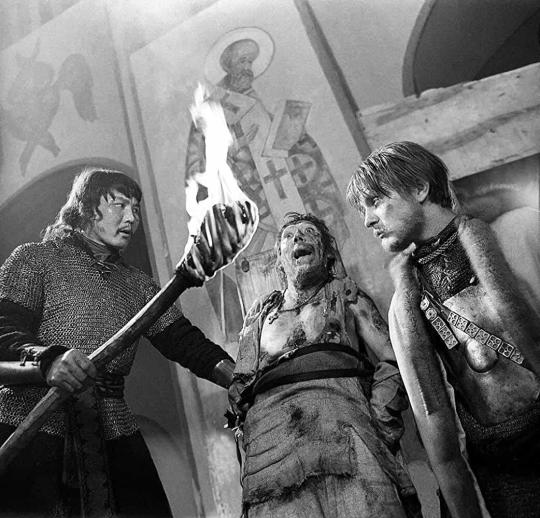
Moving through ‘a sequence of detailed fragments’ in which Rublev is sometimes present, sometimes only an observer, the film works toward difficult questions: how is experience related, and how can it be communicated? How can art be true to its subject and its audience?How do you paint the trinity without just reducing it to the sum of its parts?
At once humble and cosmic, Rublev was described by Tarkovsky as a “film of the earth.” Shot in widescreen and sharply defined black and white, the movie is supremely tactile—the four classical elements appearing here as mist, mud, guttering candles, and snow. A 360-degree pan around a primitive stable conveys the wonder of existence. Such long, sinuous takes are like expressionist brushstrokes; the result is a kind of narrative impasto.The film’s brilliant, never-explained prologue shows some medieval Icarus braving an angry crowd to storm the heavens. Having climbed a church tower, he takes flight in a primitive hot-air balloon—an exhilarating panorama—before crashing to earth. Fifteenth century Russia was a tumultuous country, never really at peace, and Tarkovsky shows this in particular in the latter half of the film. The theme of conscience is present throughout the film.Tarkovsky plays here with sound and silence, almost deafening silence.
Shooting the entire movie in black and white, Tarkovsky finally dazzles the audience with close-ups of Rublev’s works, revealed for the first time during the movie in all their brilliance and colour. After more than two hours of sombre and austere imagery, the beauty of the frescoes amazes the viewers. The art, born from the endeavours and aspirations of the artist, is presented to the audience in all its grandeur, rising over the everyday like the man on the balloon at the beginning of the movie. This universal quality of the artist and his work makes the historical period irrelevant, performing a spiritual sweep, casting an ethereal spell on the audience.
Andrei Rublev is itself more an icon than a movie about an icon painter. (Perhaps it should be seen as a “moving icon”) This is a portrait of an artist in which no one lifts a brush. The patterns are God’s, whether seen in a close-up of spilled paint swirling into pond water or the clods of dirt Rublev flings against a whitewashed wall. But no movie has ever attached greater significance to the artist’s role. It is as though Rublev’s presence justifies creation.
7 notes
·
View notes
Text
Rivera, Kahlo, and the Detroit Murals: A History and a Personal Journey
The year 1932 was not a good time to come to Detroit, Michigan. The Great Depression cast dark clouds over the city. Scores of factories had ground to a halt, hungry people stood in breadlines, and unemployed autoworkers were selling apples on street corners to survive. In late April that year, against this grim backdrop, Diego Rivera and Frida Kahlo stepped off a train at the cavernous Michigan Central depot near the heart of the Motor City. They were on their way to the new Detroit Institute of Arts (DIA), a symbol of the cultural ascendancy of the city and its turbo-charged prosperity in better times. The next 11 months in Detroit would take them both to dazzling artistic heights and transform them personally in far-reaching, at times traumatic, ways.
I subtitle this article “a history and a personal journey.” The history looks at the social context of Diego and Frida’s defining time in the city and the art they created; the personal journey explores my own relationship to Detroit and the murals Rivera painted there. I was born and raised in the city, listening to the sounds of its bustling streets, coming of age in its diverse neighborhoods, growing up with the driving beat of its music, and living in the shadows of its factories. Detroit was a labor town with a culture of social justice and civil rights, which on occasion clashed with sharp racism and powerful corporations that defined the age. In my early twenties, I served a four-year apprenticeship to become a machine repair machinist in a sprawling multistory General Motors auto factory at Clark Street and Michigan Avenue that machined mammoth seven-liter V8 engines, stamped auto body parts on giant presses, and assembled gleaming Cadillacs on fast-moving assembly lines. At the time, the plant employed some 10,000 workers who reflected the racial and ethnic diversity of the city, as well as its tensions. The factory was located about a 20-minute walk from where Diego and Frida got off the train decades earlier but was a world away from the downtown skyscrapers and the city’s cultural center.
I grew up with Rivera’s murals, and they have run through every stage of my life. I’ve been gone from the city for many years now, but an important part of both Detroit and the murals have remained with me, and I suspect they always will. I return to Detroit frequently, and no matter how busy the trip, I have almost always found time for the murals.
In Detroit, Rivera looked outwards, seeking to capture the soul of the city, the intense dynamism of the auto industry, and the dignity of the workers who made it run. He would later say that these murals were his finest work. In contrast, Kahlo looked inward, developing a haunting new artistic direction. The small paintings and drawings she created in Detroit pull the viewer into a strange and provocative universe. She denied being a Surrealist, but when André Breton, a founder of the movement, met her in Mexico, he compared her work to a “ribbon around a bomb” that detonated unparalleled artistic freedom (Hellman & Ross, 1938).
Rivera, at the height of his fame, embraced Detroit and was exhilarated by the rhythms and power of its factories (I must admit these many years later I can relate to that response). He was fascinated by workers toiling on assembly lines and coal-fired blast furnaces pouring molten metal around the clock. He felt this industrial base had the potential to create material abundance and lay the foundation for a better world. Sixty percent of the world’s automobiles were built in Michigan at that time, and Detroit also boasted other state-of-the-art industry, from the world’s largest stove and furnace factory to the main research laboratories for a global pharmaceutical company.
“Detroit has many uncommon aspects,” a Michigan guidebook produced by the Federal Writers Project pointed out, “the staring rows of ghostly blue factory windows at night; the tired faces of auto workers lighted up by simultaneous flares of match light at the end of the evening shift; and the long, double-decker trucks carrying auto bodies and chassis” (WPA, 1941:234). This project produced guidebooks for every state in the nation and was part of the Works Progress Administration (WPA), a New Deal Agency that sought to create jobs for the unemployed, including writers and artists. I suspect Rivera would have embraced the approach, perhaps even painted it, had it then existed.
Detroit was a rough-hewn town that lacked the glitter and sophistication of New York or the charm of San Francisco, yet Rivera was inspired by what he saw. In his “Detroit Industry” murals on the soaring inner walls of a large courtyard in the center of the DIA, Rivera portrayed the iconic Ford Rouge plant, the world’s largest and most advanced factory at the time. “[These] frescoes are probably as close as this country gets to the ceiling of the Sistine Chapel,” New York Times art critic Roberta Smith wrote eight decades later (Smith, 2015).
The city did not speak to Kahlo in the same way. She tolerated Detroit — sometimes barely, other times with more enthusiasm — rather than embracing it. Kahlo was largely unknown when she came to Detroit and felt somewhat isolated and disconnected there. She painted and drew, explored the city’s streets, and watched films — she liked Chaplin’s comedies in particular — in the movie theaters near the center of the city, but she admitted “the industrial part of Detroit is really the most interesting side” (Coronel, 2015:138).
During a personally traumatic year — she had a miscarriage that went seriously awry in Detroit, and her mother died in Mexico City — she looked deeply into herself and painted searing, introspective works on small canvases. In Detroit, she emerged as the Frida Kahlo who is recognized and revered throughout the world today. While Vogue still identified her as “Madame Diego Rivera” during her first New York exhibition in 1938, the New York Times commented that “no woman in art history commands her popular acclaim” in a 2019 article (Hellman & Ross, 1938; Farago, 2019).
My emphasis will be on Rivera and the “Detroit Industry” murals, but Kahlo’s own work, unheralded at the time, has profoundly resonated with new audiences since. While in Detroit, they both inspired, supported, influenced, and needed each other.
Prelude
Diego and Frida married in Mexico on August 21, 1929. He was 43, and she was 22 — although their maturity, in her view, was inverse to their age. Their love was passionate and tumultuous from the beginning. “I suffered two accidents in my life,” she later wrote, “one in which a streetcar knocked me down … the other accident is Diego” (Rosenthal, 2015:96).
They shared a passion for Mexico, particularly the country’s indigenous roots, and a deep commitment to politics, looking to the ideals of communism in a turbulent and increasingly dangerous world (Rosenthal, 2015:19). Rivera painted a major set of murals — 235 panels — in the Ministry of Education in Mexico City between 1923 and 1928. When he signed each panel, he included a small red hammer and sickle to underscore his political allegiance. Among the later panels was “In the Arsenal,” which included images of Frida Kahlo handing out weapons, muralist David Alfaro Siqueiros in a hat with a red star, and Italian photographer Tina Modotti holding a bandolier.
The politics of Rivera and Kahlo ran deep but didn’t exactly follow a straight line. Kahlo herself remarked that Rivera “never worried about embracing contradictions” (Rosenthal, 2015:55). In fact, he seemed to embody F. Scott Fitzgerald’s notion that “the test of a first-rate intelligence is the ability to hold two opposed ideas in the mind at the same time and still retain the ability to function” (Fitzgerald, 1936).
Their art, however, ultimately defined who they were and usually came out on top when in conflict with their politics. When the Mexican Communist Party was sharply at odds with the Mexican government in the late 1920s, Rivera, then a Party member, nonetheless accepted a major government commission to paint murals in public buildings. The Party promptly expelled him for this act, among other transgressions (Rosenthal, 2015:32).
Diego and Frida came to San Francisco in November 1930 after Rivera received a commission to paint a mural in what was then the San Francisco Stock Exchange. He had already spent more than a decade in Europe and another nine months in the Soviet Union in 1927. In contrast, this was Kahlo’s first trip outside Mexico. The physical setting in San Francisco, then as now, was stunning — steep hills at the end of a peninsula between the Pacific and the Bay — and they were intrigued and elated just to be there. The city had a bohemian spirit and a working-class grit. Artists and writers could mingle with longshoremen in bars and cafes as ships from around the world unloaded at the bustling piers. At the time, California was in the midst of an “enormous vogue of things Mexican,” and the couple was at the center of this mania (Rosenthal, 2015:32). They were much in demand at seemingly endless “parties, dinners, and receptions” during their seven-month stay (Rosenthal, 2015:36). A contradiction with their political views? Not really. Rivera felt he was infiltrating the heart of capitalism with more radical ideas.
Rivera’s commission produced a fresco on the walls of the Pacific Stock Exchange, “Allegory of California” (1931), a paean to the economic dynamism of the state despite the dark economic clouds already descending. Rivera would then paint several additional commissions in San Francisco before leaving. While compelling, these murals lacked the power and political edge of his earlier work in Mexico or the extraordinary genius of what was to come in Detroit.
While in San Francisco, Rivera and Kahlo met Helen Wills Moody, a 27-year-old world-class tennis player, who became the central model for the Allegory mural. She moved in rarified social and artistic circles, and as 1930 drew to a close, she introduced the couple to Wilhelm Valentiner, the visionary director of the Detroit Institute of Arts (DIA), who had rushed to San Francisco to meet Rivera when he learned of the artist’s arrival.
Valentiner was “a German scholar, a Rembrandt specialist, and a man with extraordinarily wide tastes,” according to Graham W.J. Beal, who himself revitalized the DIA as director in the 21st century. “Between 1920 and the early 1930s, with the help of Detroit’s personal wealth and city money, Valentiner transformed the DIA … into one of the half-dozen top art collections in the country,” a position the museum continues to hold today (Beal, 2010:34). The museum director and the artist shared an unusual kinship. “The revolutions in Germany and Mexico [had] radicalized [both],” wrote Linda Downs, a noted curator at the DIA (Downs, 2015:177). Little more than a decade later, “the idea of the mural commission reinvigorated them to create a highly charged monumental modern work that has contributed greatly to the identity of Detroit” (Downs, 2015:177).
When Valentiner and Rivera met, the economic fallout of the Depression was hammering both Detroit and its municipally funded art institute. The city was teetering at the edge of bankruptcy in 1932 and had slashed its contribution to the museum from $170,000 to $40,000, with another cut on the horizon. Despite this dismal economic terrain, Valentiner was able to arrange a commission for Rivera to paint two large-format frescoes in the Garden Court at the new museum building, which had opened in 1927. Edsel Ford, the son of Henry Ford and a major patron of the DIA, pledged $10,000 for the project — a truly princely sum at that moment — and would double his contribution as Rivera’s vision and the scale of the project expanded (Rosenthal, 2015:51). Edsel also played an unheralded role in support of the museum through the economic traumas to come.
A discussion of Rivera’s mural commission gets a bit ahead of our story, so let’s first look at Detroit’s explosive economic growth in the early years of the 20th century. This industrial transformation would provide the subject and the inspiration for Rivera’s frescoes.
The Motor City and the Great Depression
At the turn of the 20th century, Detroit “was a quiet, tree-shaded city, unobtrusively going about its business of brewing beer and making carriages and stoves” (WPA, 1941:231). Approaching 300,000 residents, Detroit was the 13th-largest city in the country (Martelle, 2012:71). A future of steady growth and easy prosperity seemed to beckon.
Instead, Henry Ford soon upended not only the city, but much of the world. He was hardly alone as an auto magnate in the area: Durant, Olds, the Fisher Brothers, and the Dodge Brothers, among others, were also in or around Detroit. Ford, however, would go beyond simply building a successful car company: he unleashed explosive growth in the auto industry, put the world on wheels, and became a global folk hero to many, yet some were more critical. The historian Joshua Freeman points out that “Aldous Huxley’s Brave New World (1932) depicts a dystopia of Fordism, a portrait of life A.F. — the years “Anno Ford,” measured from 1908, when the Model T was introduced — with Henry Ford the deity” (Freeman, 2018:147).
Ford combined three simple ideas and pursued them with razor-sharp, at times ruthless, intensity: the Model T, an affordable car for the masses; a moving assembly line that would jump-start productivity growth; and the $5 day for workers, double the prevailing wage in the industry. This combination of mass production and mass consumption — Fordism — allowed workers to buy the products they produced and laid the basis for a new manufacturing era. The automobile age was born.
The $5 day wasn’t altruism for Ford. The unrelenting pace and control of the assembly line was intense — often unbearable — even for workers who had grown up with back-breaking work: tilling the farm, mining coal, or tending machines in a factory. Annual turnover approached 400 percent at Ford’s Highland Park plant, and daily absenteeism was high. In response, Ford introduced the unprecedented new wage on January 12, 1914 (Martelle, 2012:74).
The press and his competitors denounced Ford — claiming this reckless move would bankrupt the industry — but the day the new rate began, 10,000 men arrived at the plant in the winter darkness before dawn. Despite the bitter cold, Ford security men aimed fire hoses to disperse the crowd. Covered in freezing water, the men nonetheless surged forward hoping to grasp an elusive better future for themselves and their families.
Here is where I enter the picture, so to speak. One of the relatively few who did get a job that chaotic day was Philip Chapman. He was a recent immigrant from Russia who had married a seamstress from Poland named Sophie, a spirited, beautiful young woman. They had met in the United States. He wound up working at Ford for 33 years — 22 of them at the Rouge plant — on the line and on machines. They were my grandparents.
By 1929, Detroit was the industrial capital of the world. It had jumped its place in line, becoming the fourth-largest city in the United States — trailing only New York, Chicago, and Philadelphia — with 1.6 million people (Martelle, 2012:71). “Detroit needed young men and the young men came,” the WPA Michigan guidebook writers pointed out, and they emphasized the kaleidoscopic diversity of those who arrived: “More Poles than in the European city of Poznan, more Ukrainians than in the third city of the Ukraine, 75,000 Jews, 120,000 Negroes, 126,000 Germans, more Bulgarians, [Yugoslavians], and Maltese than anywhere else in the United States, and substantial numbers of Italians, Greeks, Russians, Hungarians, Syrians, English, Scotch, Irish, Chinese, and Mexicans” (WPA, 1941:231). Detroit was third nationally in terms of the foreign-born, and the African American population had soared from 6,000 in 1910 to 120,000 in 1930 (WPA, 1941:108), part of a journey that would ultimately involve more than six million people moving from the segregated, more rural South to the industrial cities of the North (Trotter, 2019:78).
DIA planners projected that Detroit would become the second-largest U.S. city by 1935 and that it could surpass New York by the early 1950s. “Detroit grew as mining towns grow — fast, impulsive, and indifferent to the superficial niceties of life,” the Michigan Guidebook writers concluded (WPA, 1941:231).
The highway ahead seemed endless and bright. The city throbbed with industrial production, the streetcars and buses were filled with workers going to and from work at all hours, and the noise of stamping presses and forges could be heard through open windows in the hot summers. Cafes served dinner at 11 p.m. for workers getting off the afternoon shift and breakfast at 5 a.m. for those arriving for the day shift. Despite prohibition, you could get a drink just about any time. After all, only a river separated Detroit from Canada, where liquor was still legal.
Rivera’s biographer and friend Bertram Wolfe wrote of “the tempo, the streets, the noise, the movement, the labor, the dynamism, throbbing, crashing life of modern America” (Wolfe, as cited in Rosenthal, 2015:65). The writers of the Michigan guidebook had a more down-to-earth view: “‘Doing the night spots’ consists mainly of making the rounds of beer gardens, burlesque shows, and all-night movie houses,” which tended to show rotating triple bills (WPA, 1941:232).
Henry Ford began constructing the colossal Rouge complex in 1917, which would employ more than 100,000 workers and spread over 1,000 acres by 1929. “It was, simply, the largest and most complicated factory ever built, an extraordinary testament to ingenuity, engineering, and human labor,” Joshua Freeman observed (Freeman, 2018:144). The historian Lindy Biggs accurately described the complex as “more like an industrial city than a factory” (Biggs, as cited in Freeman, 2018:144).
The Rouge was a marvel of vertical integration, making much of the car on site. Giant Ford-owned freighters would transport iron ore and limestone from Minnesota and Michigan’s Upper Peninsula down through the Great Lakes, along the St. Clair and Detroit Rivers, and then across the Rouge River to the docks of the plant. Seemingly endless trains would bring coal from West Virginia and Ohio to the plant. Coke ovens, blast furnaces, and open hearths produced iron and steel; rolling mills converted the steel ingots into long, thin sheets for body parts; foundries molded iron into engine blocks that were then precision machined; enormous stamping presses formed sheets of steel into fenders, hoods, and doors; and thousands of other parts were machined, extruded, forged, and assembled. Finished cars drove off the assembly line a little more than a day after the raw materials had arrived at the docks.
In 1928, Vanity Fair heralded the Rouge as “the most significant public monument in America, throwing its shadow across the land probably more widely and more intimately than the United States Senate, the Metropolitan Museum of Art, the Statue of Liberty.... In a landscape where size, quantity, and speed are the cardinal virtues, it is natural that the largest factory turning out the most cars in the least time should come to have the quality of America’s Mecca, toward which the pious journey for prayer” (Jacob, as cited in Lichtenstein, 1995:13). My grandfather, I suspect, had a more prosaic goal: he needed a job, and Ford paid well.
Despite tough conditions in the plant, workers were proud to work at “Ford’s,” as people in Detroit tended to refer to the company. They wore their Ford badge on their shirts in the streetcars on the way to work or on their suits in church on Sundays. It meant something to have a job there. Once through the factory gate, however, the work was intense and often dangerous and unhealthy. Ford himself described repetitive factory work as “a terrifying prospect to a certain kind of mind,” yet he was firmly convinced strict control and tough discipline over the average worker was necessary to get anything done (Ford, as cited in Martelle, 2012:73). He combined the regimentation of the assembly line with increasingly autocratic management, strictly and often harshly enforced. You couldn’t talk on the line in Ford plants — you were paid to work, not talk — so men developed the “Ford whisper” holding their heads down and barely moving their lips. The Rouge employed 1,500 Ford “Service Men,” many of them ex-convicts and thugs, to enforce discipline and police the plant.
At a time when economic progress seemed as if it would go on forever, the U.S. stock market drove over a cliff in October 1929, and paralysis soon spread throughout the economy. Few places were as shaken as Detroit. In 1929, 5.5 million vehicles were produced, but just 1.4 million rolled off Detroit’s assembly lines three years later in 1932 (Martelle, 2012:114). The Michigan jobless rate hit 40 percent that year, and one out of three Detroit families lacked any financial support (Lichtenstein, 1995). Ford laid off tens of thousands of workers at the Rouge. No one knew how deep the downturn might go or how long it would last. What increasingly desperate people did know is that they had to feed their family that night, but they no longer knew how.
On March 7, 1932 — a bone-chilling day with a lacerating wind — 3,000 desperate, unemployed autoworkers met near the Rouge plant to march peaceably to the Ford Employment Office. Detroit police escorted the marchers to the Dearborn city line, where they were confronted by Dearborn Police and armed Ford Service Men. When the marchers refused to disperse, the Dearborn police fired tear gas, and some demonstrators responded with rocks and frozen mud. The marchers were then soaked with water from fire hoses and shot with bullets. Five workers were killed, 19 wounded by gunfire, and dozens more injured. Communists had organized the march, but a Michigan historical marker makes the following observation: “Newspapers alleged the marchers were communists, but they were in fact people of all political, racial, and ethnic backgrounds.” That marker now hangs outside the United Auto Workers Local 600 union hall, which represents workers today at the Rouge plant.
Five days later, on March 12, thousands of people marched in downtown Detroit to commemorate the demonstrators who had been killed. Although Rivera was still in New York, he was aware of the Ford Hunger March before it took place and told Clifford Wight, his assistant, that he was eager “not [to] miss…[it] on any account” (Rosenthal, 2015:51). Both he and Kahlo had marched with workers in Mexico and embraced their causes. Rivera had captured their lives as well as their protests in his murals in Mexico.
As it turned out, they missed both the march and the commemoration. Instead, the following month Kahlo and Rivera’s train pulled into the Michigan Central Depot, where Wilhelm Valentiner met them. They were taken to the Ford-owned Wardell Hotel next to the Detroit Institute of Arts. The DIA was the anchor of a grass-lined and tree-shaded cultural center several miles north of downtown. The Ford Highland Park Plant, where the automobile age began with the Model T and the moving assembly line, was four miles further north on the same street. Less than a mile northwest was the massive 15-story General Motors Building, the largest office building in the United States when it was completed in 1922, designed by the noted industrial architect Albert Khan, who also created the Rouge. Huge auto production complexes such as Dodge Main or Cadillac Motor — where I would serve my apprenticeship decades later — were not far away.
Valentiner had written Rivera stating, “The Arts Commission would be pleased if you could find something out of the history of Detroit, or some motif suggesting the development of industry in this town. But in the end, they decided to leave it entirely to you” (Beal, 2010:35). Beal points out “that what Valentiner had in mind at the time may have been something like the Helen Moody Wills paintings, something that had an allegorical slant to it. They were to get something completely different” (Beal, 2010:35). Edsel Ford emphasized he wanted Rivera to look at other industries in Detroit, such as pharmaceuticals, and provided a car and driver for Rivera and Kahlo to see the plants and the city.
But when Rivera visited the Rouge plant, he was mesmerized. He saw the future here, despite the fact that the plant had been hard hit by the Depression: the complex had been shuttered for the last six months of 1931, and thousands of workers had been let go before he arrived (Rosenthal, 2015:67). His fascination with machinery, his respect for workers, and his politics fused in an extraordinary artistic vision, which he filled with breathtaking technical detail. He had found his muse.
Rivera took on the seemingly impossible task of capturing the sprawling Rouge plant in frescoes. The initial commission of two large-format frescoes rapidly expanded to 27 frescoes of various sizes filling the entire room from floor to ceiling. Rivera spent the next two months at the manufacturing complex drawing, pacing, photographing, viewing, and translating these images into large drawings — “cartoons” — as the plans for the frescoes. He demonstrated an exceptional ability to retain in his head — and, I suspect, in his dreams — what he would paint.
Rivera’s Vast Masterpieces
Rivera’s “Detroit Industry” murals are anchored in a specific time and place — a sprawling iconic factory, the Depression decade, and the Motor City — yet they achieve the universal in a way that transcends their origins. Rivera painted workers toiling on assembly lines amid blast furnaces pouring molten iron into cupolas, and through the alchemy of his genius, the art still powerfully — even urgently — speaks to us today. The murals celebrate the contribution of workers, the power of industry, and the promise and peril of science and technology. Rivera weaves together Aztec myths, indigenous world views, Mexican culture, and U.S. industry in a visual tour-de-force that delights, challenges, and provokes. The art is both accessible and profound. You can enjoy it for an afternoon or intensely study it for a lifetime with a sense of constant discovery.
Roberta Smith points out that the murals “form an unusually explicit, site-specific expression of the reciprocal bond between an art museum and its urban setting” (Smith, 2015). Over time, the frescoes have emerged as a visible and vital part of the city, becoming part of Detroit’s DNA. Rivera’s art has been both witness to and, more recently, a participant in history. When he began the project in late spring 1932, Detroit was tottering at the edge of insolvency, and 80 years later, the murals witnessed the city skidding into the largest municipal bankruptcy in history in 2013. A deep appreciation for the murals and their close identification with the spirit and hope of Detroit may have contributed to saving the museum this second time around.
I still vividly remember my own reaction when I first saw the murals. As a young boy, the Rouge, the auto industry, and Detroit seemed to course through our lives. My grandfather Philip Chapman, who was hired at Ford’s Highland Park plant in 1914, wound up spending most of his working life on the line at the Rouge. As a young boy, I watched my grandmother Sophie pack his lunch and fill his thermos with hot coffee before dawn as he hurried to catch the first of three buses that would take him to the plant. When my father, Max, came to Detroit three decades later in the mid-1940s to marry my mother, Rose — they had met on a subway while she was visiting New York City, where he lived — he worked on the line at a Chrysler plant on Jefferson Avenue.
One weekend, when I was 10 or 11 years old, my father took me to see the murals. He drove our 1950 Ford down Woodward Avenue, a broad avenue that bisected the city from the Detroit River to its northern border at Eight Mile Road. Woodward seemed like the main street of the world at the time; large department stores — Hudson’s was second only to Macy’s in size and splendor — restaurants, movie theaters, and office buildings lined both sides of the street north from the river. Detroit had the highest per capita income in the country, a palpable economic power seen in the scale of the factories and the seemingly endless numbers of trucks rumbling across the city to transport parts between factories and finished vehicles to dealers.
We walked up terraced white steps to the main entrance of the Detroit Institute of Arts, an imposing Beaux-Arts building constructed with Vermont marble in what had become the city’s cultural center. As we entered the building, the sounds of the city disappeared. We strolled the gleaming marble floors of the Great Hall, a long gallery topped far above by a beautiful curved ceiling with light flowing through large windows. Imposing suits of medieval armor stood guard in glass cases on either side of us as we crossed the Hall, passed under an arch, and entered a majestic courtyard.
We found ourselves in what is now called the Rivera Court, surrounded on all sides by the “Detroit Industry” murals. The impact was startling. We weren’t simply observing the frescoes, we were enveloped by them. It was a moment of wonder as we looked around at what Rivera had created. Linda Downs captured the feeling: “Rivera Court has become the sanctuary of the Detroit Institute of Arts, a ‘sacred’ place dedicated to images of workers and technology” (Downs, 1999:65). I couldn’t have articulated this sentiment then, but I certainly felt it.
The size, scale, form, pulsing activity, and brilliant color of the paintings deeply impressed me. I saw for the first time where my grandfather went every morning before dawn and why he looked so drawn every night when he came home just before dinner. Many years later, I began to appreciate the art in a much deeper way, but the thrill of walking into the Rivera Court on that first visit has never left. I came to realize that an indelible dimension of great art is a sense of constant discovery and rediscovery. The murals captured the spirit of Detroit then and provide relevance and insight for the times we live in today.
Beal points out that Rivera “worked in a heroic, realist style that was easily graspable” (Beal, 2010:35). A casual viewer, whether a schoolboy or an autoworker from Detroit or a tourist from France, can enjoy the art, yet there is no limit to engaging the frescoes on many deeper levels. In contrast, “throughout Western history, visual art has often been the domain of the educated or moneyed elite,” Jillian Steinhauer wrote in the New York Times. “Even when artists like Gustave Courbet broke new ground by depicting working-class people, the art itself still wasn’t meant for them” (Steinhauer, 2019). Rivera upended this paradigm and sought to paint public art for workers as well as elites on the walls of public buildings. By putting these murals at the center of a great museum in the 1930s through the efforts of Wilhelm Valentiner and Edsel Ford — and more recently, under Graham Beal and the current director Salvador Salort-Pons — the Detroit Institute of Arts opened itself and the murals to new Detroit populations. Detroit is now 80-percent African American, the metropolitan area has the highest number of Arab Americans in the United States, and the Latino population is much larger than when Rivera painted, yet the murals retain their allure and meaning for new generations.
Upon entering the Rivera Court, the viewer confronts two monumental murals facing each other on the north and south walls. The murals not only define the courtyard, they draw you into the engine and assembly lines deep inside the Rouge. The factory explodes with cacophonous activity. The production process is a throbbing, interconnected set of industrial activities. Intense heat, giant machines, flaming metal, light, darkness, and constant movement all converge. Undulating steel rail conveyors carry parts overhead. There were 120 miles of conveyors in the Rouge at the time; they linked all aspects of production and provide a thematic unity to the mural. And even though he’s portraying a production process in Detroit, Rivera’s deep appreciation of Mexican culture and heritage infuses the frescoes. An Aztec cosmology of the underworld and the heavens runs in long panels spanning the top of the main murals and similar imagery appears throughout the frescoes.
On the north wall, a tightly packed engine assembly line, with workers laboring on both sides, is flanked by two huge machine tools — 20 feet or so high — machining the famed Ford V8 engine blocks. Workers in the foreground strain to move heavy cast-iron engine blocks; muscles bulge, bodies tilt, shoulders pull in disciplined movement. These workers are not anonymous. At the center foreground of the north wall, with his head almost touching a giant spindle machine, is Paul Boatin, an assistant to Rivera who spent his working life at the Rouge. He would go on to become a United Auto Workers (UAW) organizer and union leader. Boatin had been present at the Ford Hunger March on that disastrous day in March 1932 and still choked up talking about it many decades later in an interview in the film The Great Depression (1990).
In the foreground, leaning back and pulling an engine block with a white fedora on his head may have been Antonio Martínez, an immigrant from Mexico and the grandfather of Louis Aguilar. A reporter for the Detroit News, Aguilar describes how fierce, at times ugly, pressures during the Great Depression forced many Mexicans to leave Detroit and return to their homeland. The city’s Mexican population plummeted from 15,000 at the beginning of the 1930s to 2,000 at the end of the decade. If the figure in the mural is not his grandfather, Aguilar writes “let every Latino who had family in Detroit around 1932 and 1933 declare him as their own” (Aguilar, 2018).
A giant blast furnace spewing molten metal reigns above the engine production, which bears a striking resemblance to a Charles Sheeler photo of one of the five Rouge blast furnaces. The flames are so intense, and the men so red, you can almost feel the heat. In fact, the process is truly volcanic and symbolic of the turbulent terrain of Mexico itself. It brings to mind Popocatépetl, the still-active 18,000-foot volcano rising to the skies near Mexico City. To the left, above the engine block line, green-tinted workers labor in a foundry, one of the dirtiest, most unhealthy, most dangerous jobs. Meanwhile, a tour group observes the process. Among them in a black bowler hat is Diego Rivera himself.
On the south wall, workers toil on the final assembly line just before the critical “body drop,” where the body of a Model B Ford is lowered to be bolted quickly to the car frame on a moving assembly line below. Once again, through his perspective Rivera draws you into the line. A huge stamping press to the right forms fenders from sheets of steel like those produced in the Rouge facilities. Unlike most of the other machines Rivera portrays, which are state of the art, this press is an older model, selected because of its stylized resemblance to an ancient sculpture of Coatlicue, the Aztec goddess of life and death (Beale, 2010:41; Downs, 1999:140, 144).
On the left is another larger tour group, which includes a priest and Dick Tracy, a classic cartoon character of the era. The Katzenjammer Kids — more comic icons of the time — are leaning on the wall watching the assembly line move. The eyes of most of the visitors seem closed, as if they were physically present, but not seeing the intense, occasionally brutal, activity before them. Rivera, in effect, is giving us a few winks and a nod with cartoon characters and unobservant tourists.
~ Harley Shaiken · Fall 2019.
1 note
·
View note
Text
The Myth of Persephone in “The Narcissus And The Pomegranate”
Instead of a retelling of the myth, today we talk literary analysis!

Chapter one is an introduction to the Hymn of Demeter and this book itself. I read the Hymn a while ago and expressed my thoughts, which you can find by searching The Persephone Project tag so I won’t explain that.
Chapter two is about looking at the myth as a means of establishing Zeus as head of a Greek pantheon of gods. It analyzes the diction and the narrative aspects to conclude that one of the primary purposes of the myth was this elevation of Zeus due to patriarchal standards of the time. The reason why Zeus would even need to be elevated is that the idea of worshiping Demeter and Persephone independently was common at the time and that Persephone might actually have been worshiped even longer than Demeter but sometimes as a goddess of a different name who represented both the underworld and fertility and the duel nature of life and death before being placed subordinate to Demeter. However, although it does place Zeus as an authority by having him be the one who arranged the marriage and being the one who Persephone calls out for when she’s being taken underground (something I previously pointed out as being kind of weird), the myth also makes it seem like Zeus had no idea about the pomegranate thing while Demeter does. It also talks about Persephone’s retelling of her story when she gets back to Demeter and how she shifts the narrative and how the two goddesses have the longest speeches in the story, implying authority.
Chapter three looks at the myth with psychoanalysis and specifically the object relations theory. This is all about the idea of coming of age for a girl by following the example of the mother and then separating from her while still looking to her as an example of how to form her own womanhood. This is emphasized by how Persephone starts the story hanging with her friends away from her mother. It also talks about the narcissus being called a “toy” and how Persephone goes to pluck it as a sign of her choosing her maturity, which is then completed in a sexual maturity way by eating the seed, which is not really shown to be unwilling or willing but she later has a “me thinks the lady doth protest too much” moment when she insists to her mother that it was by force. This gives Seph a lot of agency in choosing her fate even if she didn’t technically go to the Underworld willingly. It also compares Seph to Demophon and how after losing Seph, Demeter becomes an old woman (her daughter growing up makes her old, get it) and then tries to basically replace her with Demo since her daughter has “died” but she can try to make him immortal.
Chapter four looks at the myth through anthropology and different rituals and coming of age rites that used the Hymn (the Eleusinian Mysteries obviously, the Haloa, and the Thesmophoria). Ultimately the author concluded that while there are some similar elements and stages, they don’t fully add up with what we know about ancient history. It talks a bit about how Persephone doesn’t start the story with her mother but with her friends, putting her already in a liminal state between childhood and adulthood. It also talks about how a lot of the similar rituals of the time that weren’t coming-of-age focused on fertility but Persephone doesn’t ever become pregnant and doesn’t even stay in her husband’s home as one would expect from a marriage ritual (although it does emphasize that sex did happen since they are on a bed and she eats the seed but that marriage is actually kind of ambiguous unless it’s supposed to be implied by the sex).
Chapter five looks at the myth as a hieros gamos, a “sacred marriage” rite common in a lot of early religions (I actually know of it best through the modern Wicca representation but even when I first heard about the Wicca version, I was like, “hey, this is kind of like Hades and Persephone”). The idea is that the coupling of an earth goddess (both above and below) and her kind of useless male consort brings about the fertility of the earth and people. It does mention that this coupling is usually on earth and not underground but that this speaks to the duel nature of nature and death in the Hymn (also cool is how many modern interpretations have them actually coupling in her garden instead like “Hadestown” and Allison Shaw’s comic; it’s more traditional). It mentions how Demeter and Persephone were once probably one goddess and Kore and Persephone were the two split ideas and how Zeus and Hades were one god of different aspects but then split into two gods (I’ve read about this before with Orphic tradition). Even Poseidon was part of this as water leads to vegetation. All these cults got smushed together and altered. Apparently, like with the Wicca idea, the god is usually the subordinate who has a coming of age and the sacred marriage to a powerful goddess but that patriarchy lead to this role being given to Persephone. It also compared the hieros gamos of Seph to one of Demeter and Poseidon (the one with horse rape and Desponia) and talked about cults where the marriage was between Kore and Plouton, a grain god who’s name is very similar to Pluto. There’s a cool footnote where the author notes how another author saw Persephone’s lack of offspring as a result of her being a goddess of death but the author contests that she is a goddess of the dead, not death and that her role is that of receiver and caretaker, not the bringer of death. This was a really interesting chapter to me as it heavily discusses the evolution of myth over time.
Chapter six discusses potential earlier ideas that would eventually be shaped into the Hymn. It again brings up the idea of Persephone as a Bronze age goddess without Demeter or the idea that Demeter as mother was a different aspect of Persephone who is also a maiden in one aspect (citing Homer mentioning her without Demeter and as just Underworld Queen). It discusses the ambiguity of who actually is responsible for the earth’s fertility, addressing that in the Hymn it’s Demeter and that Persephone only brings about the seasons and specifically mentions flowers, not things like food (although she probably did both in earlier history). There were a lot of things in this chapter mentioned before just in a more focused form. One of the new ideas was in an Orphic tradition version, Demeter went into the Underworld herself to get Persephone. It is also suggested that the part of the Hymn where Demeter goes to Eleusis, which doesn’t really have anything to do with the main narrative, was an effort to include rituals that were already present there and establish Demeter as an authority there over Persephone (known as Kore/Thea).
Chapter seven talks about the linguistic history. It discusses when the Greeks started speaking Greek and mentions how Persephone’s name is older, not Greek, and not really understood. It discusses how her previously common adjective as “dread/awesome” is dropped for the Hymn to only describe her as young and beautiful while Demeter is given more power-based descriptions in addition to her appearance. It breaks these words into list form in Appendix B, which I find helpful. It then discusses Demeter’s name, which is Greek, with the first syllable either being connected to earth or water and the other two being mother and it talks about the name Hades, which is usually seen as Greek and translated just “unseen one” but there is some debate. It ends with a lot more discussion of Demeter.
Chapter eight discusses archaeological evidence to find the source of Demeter and her joining with Persephone before the Hymn was written. The book discusses early Persephone concepts in a cup found at Phaistos in Crete from 1900 BCE (and other Minoan goddess concepts), frescos at Akrotiri in Santorini a few hundreds years BCE, and 9th century BCE art in Arkhanes Crete but there’s no indication of names or of any worship of Demeter or Persephone specifically and together until the fifth century BCE. Then the book looks at grain goddess ideas in Mycenae dating back to the 13th century BCE and potential art of paired goddesses who could be early ideas of Dem and Seph. Then it looks at Sicily where Persephone, the life and death goddess of another name, was heavily worshiped independently from the third millennium BCE (and the island was seen as a wedding gift from Zeus). Then it goes to mainland Greece to talk about Eleusis (I enjoyed a mention of clay pomegranates at Eleusis) and Corinth (and some ambiguous two women figures from there). Ultimately, a lot of the results are very interesting but also very speculative because how could we know?
Chapter nine mostly sums up a lot of points in the book in regards to the formation of the myth and its history.
Overall, this was a really interesting read! I don’t know how accessible it is to people who don’t have a large background in this stuff so I’m not sure if I’d recommend it but it’s probably a solid read if you like the myth, archaeology, anthropology, or any of the other things it talks about.
12 notes
·
View notes
Link
Jonathan Groff decides we should take advantage of what might be New York’s last suitable night for al fresco dining in 2019. He sits down at one of a dozen empty tables outside the otherwise packed Hell’s Kitchen bistro and announces, in a tone suggesting more mischief than regret, that he must first make a call.
"Hello," he says, iPhone now at his ear. "Joel Grey?"
Groff is starring in a limited revival of Little Shop of Horrors, and it is a very hot ticket. The Broadway legend on the other end of the line has apparently thrown a Hail Mary in hopes of scoring seats to the night’s sold-out performance. Hamming up this exchange for my amusement, Groff is game to play broker for the Tony and Oscar winner who originated the role of Cabaret’s tuxedoed emcee — and, maybe, anybody else who has his number.
"This is basically my part-time job," says Groff of fielding requests, jotting down credit card information and negotiating pickup times and locations for friends both famous and civilian. "It was the same thing when I was doing Hamilton," he adds of his year playing King George III in Lin-Manuel Miranda’s hip-hop history lesson. "But I was really only onstage for nine minutes during that show, so the tickets were probably full-time."
The 34-year-old actor seems eager to please, not unlike current alter ego Seymour. Little Shop’s nebbish, sweet and ultimately doomed florist nurtures a manipulative plant even as the pet’s homicidal tendencies grow more and more apparent. Those familiar with the campy musical comedy know that it suffers no shortage of blood, but it’s a nursery rhyme compared with Groff’s recent work on truecrime thriller Mindhunter. Playing a curious FBI agent in David Fincher’s Netflix series has perhaps done more for his ascendant profile than anything yet. But two seasons on the drama have meant two nine-month stints in Pittsburgh, filming interrogation scenes with character actors who bear uncanny resemblances to famous serial killers.
So even on a two-show day like this late- October Saturday, the rigors of theater are easy work for Groff. Over a couple of hot toddies, in between humoring three smitten waiters at the restaurant at which he’s been a regular since Little Shop went into previews down the block, the actor appears to be in his element. "Theater is such a communal, familial medium and interactive experience," notes Groff, who says he recognizes faces in the crowd during most performances. "Mindhunter, for me at least, is a very private experience."
Groff plays against type on Mindhunter. Wide-eyed with an almost perpetual grin, his is a mug you wouldn’t be surprised to find in an illustrated Merriam-Webster — cozied up to the entry for "baby face." Much of his previous acting career leaned into this, starting with his breakout. The Pennsylvania native came to New York at 19 and landed the lead in the musical Spring Awakening by the time he was 21. "I was just auditioning for the ensemble of Broadway shows," says Groff. "I hadn’t really developed the taste to appreciate something like Spring Awakening until I was in it."
New York’s "It" Broadway show of the aughts, the rock opera about sexual discovery among 19th century German teenagers earned Groff his first Tony nomination. He spent two years in the production before leaving in 2008, at the same time as friend and co-star Lea Michele, to pursue film and television. The work that immediately followed — Ang Lee’s Taking Woodstock, a recurring spin on Michele’s Fox hit Glee, a supporting role in the second season of Kelsey Grammer’s cult drama Boss, voicework in Disney $1.3 billion smash Frozen (he’ll reprise his role as Kristoff in Frozen 2, out Nov. 22) — got him on the radar for vehicles of his own. When HBO began casting Looking, its 2014 dramedy about a group of gay friends navigating an evolving San Francisco, Groff was soon tapped to front the series.
"He will search for the best version of every scene and will work until everyone drops," says Looking executive producer Andrew Haigh, who cast him as Patrick — boy-nextdoor- ish, like the actor, but privileged and problematically fickle. "He is also wholly unafraid to be vulnerable onscreen."
Looking lasted for only two seasons and a wrap-up movie, and its premature demise allowed Groff to do Hamilton, which he joined while the show was off-Broadway in early 2015, and then made the jump to Broadway. His supporting part as the aforementioned royal — with interstitial lamentations for the seceding Colonies, sung like a lovelorn (and supremely pissed) Davy Jones — earned Groff his second Tony nomination. But Groff wasn’t long for Hamilton, either. He was circling his next TV project, a moody prestige procedural about the early days of the FBI’s Behavioral Science Unit, based on the 1995 memoir Mindhunter by criminal profiler John E. Douglas.
"I’m not naturally a true-crime person. So reading the book, I was like … 'oh, fuck,' "says Groff of John E. Douglas’ memoir 'Mindhunter.'
Mindhunter, the book and the series, delves into the morbid minutiae of notorious murder cases with an emphasis on interviews between law enforcement and criminals in the late 1970s and early 1980s. Groff was in contention for the role of FBI agent Holden Ford, based loosely on Douglas. First, he had to prove to director and executive producer Fincher — a filmmaker long admired by Groff, who says he has "a boner for his brain" — that a jovial Broadway star most widely known for singing with a reindeer in a Disney cartoon could have the upper hand with serial killers.
It was not Groff’s first audition for Fincher. Seven years earlier, he was in the running to play Napster co-founder Sean Parker in The Social Network. "My agents said, 'You have an audition in L.A. with David and Aaron Sorkin,' " Groff recalls. "If you get it, you start rehearsal the next day, so pack your suitcase for two months. They really like your tape, but they’re also considering Justin Timberlake." The part went to Timberlake.
"I did not feel then — and still don’t — that he had the inherent venality for that role," Fincher says of Groff. "He is as decent and sensitive as anyone I’ve ever met."
If venality is off the table for Groff, darkness is not. And though casting the song-anddance man was a source of curiosity for some in Hollywood before Mindhunter’s 2017 debut, the finished product didn’t elicit any skepticism from critics. Over the first season, Groff’s character goes from eager, milkdrinking company boy to a shell of the man introduced in the first episode. He alarms colleagues with the way he mirrors serial killers, until he has a panic attack after getting a bear hug from a necrophile. The second run, equally well reviewed after its August debut, saw a somewhat recovered Holden sit down with Charles Manson and, for the dramatic fulcrum of the season, investigate the Atlanta child murders of 1979-81.
"It is so impossibly bleak that I don’t think about it while I’m doing it," says Groff, who confesses he finds watching the show more affecting than making it. "All due respect to people who feel like the character is inside of them or whatever, but I don’t have that. I would leave set, listen to Beyoncé, and that was it."
After an hour and a half in his company, Groff reveals himself as a Lucille Ball historian, an avid bike rider, a devout New Yorker and someone who doesn’t seem easily bummed out — except when the conversation turns to success. His excitement over landing Mindhunter, he says, was immediately diluted by a pang of sadness. "Whenever something really great happens, it makes me feel a little bit depressed," he says. "It’s like, this is never going to get better than this moment right now. I’m sitting in David Fincher’s office and he’s giving me this role."
Talk of a third season of Mindhunter is on hold while Fincher focuses on his next feature. But the director did take a recent break from Mank, a biopic on Citizen Kane screenwriter Herman Mankiewicz, to attend Groff’s first Little Shop matinee with wife and fellow Mindhunter executive producer Céan Chaffin. It was a surprise appearance, but only because Groff hadn’t been checking his text messages. "I’m not good at my phone," he admits.
Groff has not looked at his phone since that one call — which, while polite, now has him in danger of running late for curtain. He breaks the bad news of his immediate departure to one particularly adoring waiter, and we walk to the stand where his bike is locked. There, he pulls from his bag a cobalt helmet that could double as Tron cosplay. Bars of blinding LED lights on both its front and back, his headgear tells cabs to get the hell out of the way and signals to everybody else that this is a man who values safety over subtlety.
"Yeah, I do really love riding my bike in the city … I’m just not that hard-core," Groff says of the helmet before encasing his tousle of sandy chestnut hair for the one-block ride to the theater and an expectant Joel Grey. "My mom bought this for me."
31 notes
·
View notes
Text
BNHA self insert AU [Book 2]
Lost and confused? See this post to catch up!
Chapter 3: *Nicki Minaj Only Meme on Loop*
“Who did you choose Lili?” Hoshi asked me on our way to lunch at our usual spot “you kept quiet when some of us were sharing in class.”
“I chose the other offer” I stretched my arms “my parents were freaking out over it, so it must be good.”
“Oh dang both of them?” I nod as we sat at the stone table “well I trust your mom’s word, so I guess you chose well.”
“See, like, I’m not sure if I made the right choice” I opened my lunch bag “yea we have the same quirk but what can he show me that I already don’t know?”
“He was a top hero before, I’m sure he can bestow some knowledge on how things used to be?” he peered into my bag “did your mom pack lunch?”
“How can you tell?”
“I don’t recognize a single food product in that bag aside from the cut mango” he snickered “what’s for lunch?”
I peer in my bag “A torta, hot cheetos, mango con chamoy and an Arizona green tea” I gasped as I grab one of the items “OH BOY A TWINKIE YESSSSSS!”
“What’s a twinkie?”
All jazz music stopped in my head “You’ve never had the joy of having the delicious, golden, creme filled wonder that’s a twinkie?!” I watch him shake his head cautiously “here, today I’m blessing you with some American culture that my mother took for granted when she lived there.”
He looks at me presenting the twinkie in my open palms “You sure? From your guttural screech earlier, seems like you want it more.”
“As a proud half latina-American, I can’t be selfish with food experiences” I put the wrapped snack cake in his hands “on my momma’s word they’re good!”
“I did say I trust your mom” he unwrapped the twinkie and took a bite, his eyes widened and glistened “oh my god, Lili what the fuck?” he took another bite and savored it “this is the best thing in my sad, pathetic life!”
“I said the same thing when I was 6 years old” I recalled “good times! Now my siblings and I get in near fist fights over them. Mom keeps them under lock in the snack pantry so we never know if there’s any.”
“Fist fights? You 4 seem to get along so well” he finishes the snack “I guess nobody gets in the way of your imported snacks huh?”
“Yup!” I pick up my torta and take a bite “oh fuck yea! she put extra queso fresco in mine!”
After a very passionate lunch of me just explaining ethnic eating, we go about the rest of our day as usual. I countdown the days until I need to go to my internship, according to his requests, I have to bring a lot of extra things.
“That’s quite the line of luggage you got there” Hoshi commented on my 3 rolling suitcases and large duffle bag “you need help?”
“No, I’m fine” I take a calming breath “my ride is going to come any minute now” I look at my phone for the time “looks like you should get a move on too, the train to Saitama is departing soon.”
“Okay then, I’ll see you in 2 weeks” he grabbed his costume case “um text me when you get to your destination?”
“I will, take care!” I smile at him. I watch him start to walk away, then turned back to hug me “Oh?”
“Sorry it’s just that I needed this” he squeezed a little tighter “my mom would hug me good bye all the time when she had to go away for days at a time, it doesn’t feel right for me to say bye without a hug.”
That made me soft and a little sad that I reminded him of his mom. The best I could do was hug him back until he had to run off to catch his train. Not long after, a town car rolled up to where I was waiting.
“Hello Miss, are you Iida Lili Perla?” spoke the man in the drivers seat.
“Are you from the Best Jeanist agency?”
“Yes I am! Very nice to meet you” he gets out from the car and I can see the tent like pants in full view “I’m Jinko Punky from the Best Jeanist agency” he bows “it’s an honor to escort one of Agent 19′s very own.”
“You know my mom?” I was very confused on how this man knows my mother’s agent number and why he addressed her as such.
“Yes, she’s a very beloved agent in the agency” he gestured to my luggage “but lets load these into the car and I’ll explain things as we go.”
I help him put my things in the trunk and sat in the front of the car. The more I think about it, the more I’m confused on this man’s appearance “Alright, let me explain more, I bet you have a lot of questions.”
“Yes, my parents were freaking out over this offer. But all I know is that he’s a retired hero and my mom interned under his agent sector.” I couldn’t stop looking at his ugly tent pants “what does he want to do with hero work after all this time?”
“He’s an eccentric man, and he adored your mother when she was your age” he chuckled “I’ve never seen him so soft after interacting with her, like something in him changed for the better.” He sighed “Your mother showed her loyalty to us and helped in solving cases and gaining very valuable intel that no other could get! But what a strange twist of fate that her daughter is doing the same thing?!” We drive another 20 minutes and we arrive somewhere in Taito “Alright, this is your first destination.”
“First destination?”
“Yes, for this week you’ll be with the man himself” he unloads my bags “and next week you’ll be at the agency.”
He leads me into the building and tells me which floor and room I should go to. As I ascend to the top floor, I get nervous on how this man is going to be and what my mother felt when she met him. Finding the room wasn’t hard and I knocked on the door.
“Who’s there?” responded a semi-robotic voice.
“This is Lili Iida, from UA heroics program.”
I heard a click and the door opened “Please come in!” greeted a long-haired, white cat “I’ll let my owner know you’re here, please have a seat on the couch.”
I watched the cat trot away in awe. It was one of the fancy cat robo models my mom’s company developed! If I remembered correctly, the model name is Chiffon and was named after somebody’s beloved cat that passed away of old age. I looked at the room around me, it was spacious and clean. Seemed almost too big for just one person to be living here but there wasn’t any pictures of a family to show that more people lived here. Actually, there wasn’t any pictures on the wall, just artwork and hanging houseplants. I caught a glimpse of a silhouette of a tall figure coming closer from the hall the cat went in. I stood up and there he was, tall and in all denim.
“Hello there” he stopped in his tracks when he saw me “it’s very nice to see you after so long. My how you’ve grown up!”
I felt so comforted somehow after he spoke to me like we were family “I wish I could say the same about you” I bowed “I’ve heard so much about you!”
“Oh child, don’t bow to me” he walked up to me and tilted my chin up “we’re like distant family. Did Jinko explain things?”
“Yes he did” I stood up straight, unsure on how I should be addressing him “I’m going to be under your guidance this week and next week with the agency.”
“Correct” he turned toward the other side of the room “come this way, I’ll show you to your room for this week.” I follow him with all my things “here’s your room, it’s a bit plain but you’ll have your own bathroom and don’t mind the mannequin busts.”
I walk into the room and it was white and gray with a large window and decent sized wardrobe “Thank you, um”
“Um? OH my name!” he caught on to Lili’s struggle “call me Mr. Hakamada, I don’t like being called sir.”
“Okay, got it Mr. Hakamada!” I smiled.
“Great, I’ll let you get settled and meet me up in the loft when you’re done” he turns to leave “and wear a practice suit, training starts today.”
I watch him leave and the nervousness sets in. Never in my life has fear struck me! Dad said I was a fearless baby and rarely cried but I’m feeling a bit like a child. Probably just the fact that this is a pro-hero that’s way more experienced than my dad and has the same quirk. I put on my leotard and muslin stash and make my way to the loft. His place has hard wood, so you can hear me clicking about on my pistons. If I were sneaking, I’d be so dead, but I put on my rubber soles so I don’t ruin his floors. The loft was just as spacious but it looked more like a dance studio but without the mirrors. He sees me and starts to give me that ‘what are you wearing?’ look.
“Is there something the matter?”
“It just that” he pointed at my sash “that muslin doesn’t go with your whole look, what do you use this thing for?”
“Oh this is my extra layer when I do quirk practice” I explained “I can control any fiber cloth material and make anything! As long as I have a mental reference of said thing or I’ve practiced making something.”
“Any fiber?” he said in awe “then I’ve underestimated you!” he unraveled his denim turtle neck “you have a wider range than I do, but can you think fast!”
I almost got caught in his string attachment attack, thank the lord for rocket feet! I unraveled my sash “I can do more than that!”
“Lets see how you feel about not being able to move!” he wrapped my ankles together “hard isn’t it?”
“Two can play at that game!” I binded his pant legs together with my sash “now who’s vulnerable?!”
“You, you don’t have anymore cloth to use” he smirked “you have much to learn.”
I pulled the ribbons out of my hair and used them to bind his wrists together “You don’t tell me when the fights over, I DO!”
“Okay okay, I surrender” he chuckled “you really are your mother’s child.”
I un-binded him “How so?”
“She has the same battle attitude” he freed me from my ankles “it’s a little dangerous how that passed down to you, actually, it’s strange how she created such a child.”
“What do you mean?” I was curious “I’m just doing what feels right.”
“I saw your spars at the sports festival and I was just impressed that you graced the stage with your presence and dance-like moves” he sat on the floor and I followed suit “all the techniques you did like the puppeteer move and the sling were very reminiscent of your mother and I knew I had to mentor you.” He picked up the piece of ribbon that hanged on his wrist “I consider your mother more like my daughter, and I guess making you my grand-daughter.”
“Like a daughter?” that make me think “do you have a family?”
“I don’t, it’s one of my regrets in life” he sighed as he tied the ribbon into a bow “I spend my time working on being a top hero that I just lost contact with anybody remotely interested in me. All my friends were in hero work so it didn’t hit me that I was alone until one of my side-kicks asked for paternal leave because his wife was due any day and he wanted to be there for her and the baby. That really put my life in perspective, what does it matter if I’m a top hero if I don’t have anybody to come home to?” he pulled at the bow to undo it “then I met your mother, a young but tragic girl that wasn’t ready to leave her parents. I felt the need to care for her, so I’d check up on her and such. I went as far as giving her some spending money and giving her gifts on her birthday and Christmas! In return she always lends her abilities and comes to me for help.” He gasps “I can show you actually, come with me.”
He leads me to his workroom, bolts of fabric on the wall and other cloth pieces scattered about. He hands me a photo album “What’s this?”
“I have pictures of your mother when she was your age and other life stages” he opened the book “That’s her when she first arrived, that’s on her last day of her internship” he flips a few pages “here’s what I wanted to show you, I’ve created all of your mother’s iconic looks.”
“All of them?! I’ve only seen some of these in magazines and video!” I was in awe at all of my favorite looks “the whole reason I got into making my own costumes for dance was because I was inspired by some of these iconic looks” I pointed at a picture “like her blush pink power-business suit and the electric blue geometric dress at her Techies Gala premiere!” I turn the page and saw pictures of my parents “you made those too? My dad must’ve really loved my mom to be matching with her in these get ups!” I turn another page “that’s the wedding! You made her wedding dress?! Mom won’t even let me near that dress! I loved the sleeves and the shape of the train, especially the obi.” I pointed at my sash “it was my inspiration to my hero costume, I have an obi like middle that I use in battle.”
“You like my works to that point?” he was flattered “oh sweet child, I hoped you liked my designs” he turned to the next page “do you remember this dress?”
“Oh hey thats me!” I look at the picture of me in my toddler years “I loved that dress so much I never wanted to take it off! I cried when I out grew it but by then I could make another one with my quirk.” I looked at the pictures before it “oh, those are also me. You did hold me when I was a few weeks old.” I look up at him “why didn’t you visit?”
He sighed “I joined the fashion scene under an artist name and got very busy” you could feel the guilt in the air “I was traveling to China and Milan, parts of Europe for work and I just didn’t really have time to come by and visit.” he smiled “but your mother always sent me pictures of you and your siblings. On those rare days when our schedules align, we go out for some dim sum in disguises. On my rough days, I look at the pictures of you guys and it makes me feel like I’m working hard for my family and it gives me purpose to keep going.”
“Well, if it gives you purpose then I’m happy to be part of your family” I smile back “should we go back to training?”
“I think we’re good for today” he checked the time “it’s nearly time for dinner, what would you like to eat?”
“Rice and cold dish!” I tap my feet excitedly.
“Alright then, lets start cooking” he makes his way to the kitchen and I follow him. We have pleasant conversation over food and I felt less nervous around him. “Oh and before I forget! We’re going on a day patrol in plain clothes, be sure to be ready to go at 8am.”
I paused before I made my way to my room “Plain clothes at 8am, got it!”
“Good night Lili”
“Good night Mr Hakamada”
-Next morning-
“Alright, it’s just a short ways this way” he said as we hopped off the train “reason why we’re patrolling here is for more insider experience.”
“What do you mean?” I was a bit confused on why he couldn’t just tell me.
“You’ll see” he stops in front of a 3 story building “we’re here.”
After a few turns in the winding hallways of this place, he opens the door to a large professional fashion workroom “Oh my goodness! It’s the ICONIQUE workroom!” I turn to him “you work for them?!”
“I do, after your mother’s wedding dress went viral” he took off his scarf and light coat “it caught wind of this place that wanted to know who I was and wanted to give me a spot to design and create without the media knowing it’s me.”
“That’s so cool! What do you design here?” I look at the half finished gown on a mannequin “I’ve only seen snapchat stories of this place and they have different featured categories.”
“I do the statement and traditional designs” he points to a covered mannequin “this is what I just finished but yet to be featured on the platforms” he pulled the cloth covering to show me “a chiffon kimono with the obi to match.”
“OOOH! Translucent!” I loved this bold traditional piece “what an honor to get the insider on the next feature!” I remembered why I was here, not to tour this place but to do my internship “oh! what’s the reason to bring me here?”
“The point of being plain clothes patrolling is to lead a double identity” he hands them a lanyard with a badge “today, you are my understudy, Miss Natalan Ono. You are an arts student that was selected to observe and assist me on my next piece.” He sat at this work chair “You’re a legacy child because you’re related to Yoko Ono and is following in their footsteps. Now, back-stories aside, your role is to observe everyone and report suspicious activity to me. Nobody knows who I was before and I’ve noticed some suspicious heads.”
“Got it! One question though” I pointed at my badge “why Yoko Ono? Doesn’t the arts community hate her?”
“Yes but I’m not that creative” he chuckled “your mother is the master of backstory, maybe you can fill in some of the blanks that I left.” He swiveled to his work bench “now, can you get me some tea from the lounge? We passed it in the hallway.”
“Sure thing!” I put the badge on and made my way to the lounge. There were quite a few people in there and I was on high alert for any suspicious activity.
“Hi there!” called out a cheery voice as I poured some tea “haven’t seen you around here before? Are you a new hire?”
I gulped hard before turning to them, think of something Lili! “Um hello, I’m sadly not a new hire” I fixed my glasses shyly “I’m just interning for someone.”
I see their eyes shift to my badge, their smile disappeared “Oh...you’re that Ono legacy child Hakamada-kun has been talking about” she gave me a dirty look “I don’t care how good you are, you don’t deserve to be in his presence!”
“Um if I may ask, why do you think I’m not worthy?” I was getting whiplash from their change of tone.
“He’s a genius! Not to mention tall and brooding, nobody understands him except me!” she was giving off major yandere vibes and I was getting scared “he might turn down my help but it should be me in that workroom!”
I watch her turn away and the others in the room were staring at me now. Oof I probably gave myself away for everyone to pester me. Making my way around that office was harder now, everyone was giving me dirty looks and didn’t talk to me.
“Ready to go?” He asked as he put on his scarf.
I check the time, it was 5pm “Let me just get my bag and I’ll be ready.”
“How was your patrolling?”
“Awful, everyone was giving me dirty looks after that one yandere lady approached me.”
“You had the displeasure of meeting her huh?” he cringed “I have a feeling she’s taking her obsession a little too far.”
“What makes you believe that?”
“Well, some of my key patterns come up missing and it forces me to talk to her because she’s in the patterns department” he recalls “some of my embroidery hoops get roughed up when I want to use them, and my mannequins get moved around every time I come in the studio.”
“If that’s the case, then I guess some confrontation will have to do” I walk with him down the hall to leave and we run into her.
“Oh! You’re heading out for the day?”
“Yes I am, my intern and I were going for some dinner before going home.”
My heart stopped, why the fuck did he say that? Now it sounds like we’re in a relationship! Say something Lili! “As a thank you for taking me in! We should get going Mr. Hakamada! My parents are waiting at the dim sum place” I bow to the lady “it was nice meeting you! Have a nice evening.” We scurry out of earshot “What the hell are you trying to do! Get yourself accused of romancing your intern in front of a yandere?!”
“I realized my mistake the second it came out of my mouth” he turned red “I have a feeling I’m going to see a lot of things missing tomorrow.”
We get home and spend time just hanging out, cooked dinner and pleasant conversation. Just like a family, but I knew in the back of my mind that it’s not a pleasure stay here. It was almost like he arranged things to be like this so he wouldn’t be alone. We went to the studio the next day to find no mannequins in the room.
“Oh this is bad Lili” He said as he checked all around the space for one “I have to present this chiffon kimono today for the media directors to post on the platforms.”
Think Lili, THINK! “Does it have to be on a mannequin?”
“No but where am I going to find an alternative in time?”
I give twirl “I might of gained some muscle on my slender physique but I’m a good clothes model” I point to the bolt of muslin “we can make a full body suit of muslin on me to mimic the look of one but I do some movement and complex posing.”
“You know what, I love that idea” he took the bolt out of the wall of fabric “Lets get started!”
It took almost an hour to get me ready for the spread but of course the yandere lady walks in on him dressing me in the kimono.
“Oh! Is that what you’re presenting today?! It’s gorgeous!”
“It’s my greatest work yet” he sighed “say, have you heard of all the mannequins going missing?”
“Can’t say that I have!” her tone was so fake, I wanted to punch her in the face “why? Have yours gone missing?”
“They have! But my intern is on the case” he was ad libbing “She’s amazing and quick thinking! She’s at the head of security right now checking the security cameras for theft.”
“Is that so? I hope security doesn’t give her trouble” you can hear the panic in her voice, wish I could see her face “well I’ll go fetch her for you.”
He waits for her to leave “Thanks for not moving, that would’ve set her off.”
“I was trying so hard not to call her out or punch her face!” I huffed “seriously, the nerve of her!”
The people came in to take pictures and such. They were surprised to see that I was the mannequin and said that it adds to the aesthetic of the garment. It was cool to see how they set things up for showcasing, I couldn’t wait to tell Rosa and my mom that I was the model for the garment! Once everything was done, I unraveled the muslin off me and I looked at myself in the mirror with the kimono on. I loved the shade of pink and the shape of it, I couldn’t stop looking at myself.
“You really love that garment huh?”
“I do! I’ve been a fan of kimono and all the traditional Japanese clothing” I look at him from the mirror “when I get married, I want to have a Japanese wedding and wear my mother’s obi and a custom kimono.”
“I hope to be in attendance then!” he chuckled as he came up behind me in the mirror “will this old man have a place in the audience?”
I turn to face him “Always, aren’t we family?” I hugged him “I don’t care if this is a little weird.”
“Oh child” his voice cracked a bit “you’re as loving as your mother” he hugged back “I wish I could’ve been there to see you grow up.”
“Well, I’m still growing” I didn’t break the hug yet “it’s not too late, you can still be in my life as I go through hero school and become a dancer.”
“Hmmm, why did you go the hero route?” he broke the hug “you clearly have a passion for dance and costuming.”
“Well, aside from not getting into any of the schools I applied to” I felt like I got caught “I’m attending UA to spite my dad. He puts pressure on me as the oldest to follow in his footsteps but I don’t want to be one of the great and noble Iida family!” I stomped my feet to show my frustration “I want to go to a dance academy but mom says I’m too young to be sent away like that. So the plan is to get strong and more than capable to be sent away for dance academy like I were to go to college. That way I can defend myself to give my parents the ease of mind while I’m away.”
“Are you planning to use your hero skills in anyway?”
“Um, uhhh I’m not sure” that really got me thinking “maybe if dad decides to step down as Ingenium, then I could take over if need be.”
“So you’re here with no plan and no real motive?”
“No sir” if he put it like that, then I feel guilty for being here.
“Child, I’m not here to shame you” he got down to my level “I want to give you motive to be the best hero you can be, even if you don’t plan on being one per-say.”
“Huh? How can I be one without being one?”
“You can inspire a new type of hero” he put his hands on my shoulders “being the dancing hero that graces the stage and apprehends villains. Who knows, you might even start an academy of your own!”
“Dancing hero...I like the sound of that!” I smile and hop in place “do you really think I can be an inspiration?”
“Your mother did, I don’t see how you can’t” he stood up and put his hand on my head “come on, we have some more work to do.”
I take the garment off and get back to being his intern. His words filled that void of belonging in this hero world. He tells me more stories of his hero days when we got home, like a grandfather telling stories to their grandchildren. Now I really feel like I’m at a family member’s house and not at my internship!
“Hey can I call you grandpa?” I asked before going to my room for the night “like in a respectable way?”
He looked at me in shock but then thought about it “You may as long as it’s respectable.”
“Okay then!” I watch him walk to his room “good night grandpa!”
He stopped to respond “Good night Lili.”
The next day we did actual training and I was engrossed in everything he was teaching me. From the way I’m supposed to move to the new techniques I’ve never heard of...everything was being soaked in. Because now I have purpose, I don’t want to spite my dad, I want to make grandpa proud of me! I want to be a hero that little 5 year old me would be inspired by to start dancing and feel confident in their rocket feet...I know what I have to do now.
-Chapter 3, End-
<Previous - Next>
#bnha#mha#self insert au#Book 2 chapter 3#not canon#will update regularly#ask me anything#//Palma-sama Speaks#*tongue pop* the development#*chef's kiss* the newfound purpose#yea I made Best Jeanist into a grandpa figure but it all part of the development of the story#I see that a bunch of yall like Lili and it makes me uwu#and don't worry! the other Iida siblings will have their turn! stay tuned!
1 note
·
View note
Text
Longing for ancient worlds
I’ve been a fan of Assassin’s Creed series for many years now. I replayed early games many many times, I own several collector’s editions and I’ll forever be angsty that I missed Evie Frye statue and now it costs like, 200$ minimum. Unity put a temporary stop to all that (it took me TWO YEARS to finish the main story, it was such a slog) and I didn’t check any of the later games until now.
Earlier this year Irian (my wife!) and I visited Rome - and that of course meant I had to replay the whole Ezio trilogy (let me just say that seeing Colloseum in real life after climbing it in game is AMAZING). Riding on the nostalgia, I decided to finally give the new games a chance. I loved every freakin’ second of Syndicate. It had almost everything I wanted from Assassin’s Creed game - it had great parkour, it had beautiful world, decent anchoring to history, great main characters... I honestly think it’s the most polished AC game there is.
Then I picked up Origins. You know, that game when they saw how horrendously big fail Unity was and decided to “tweak the formula”. It was fun, though it felt much less assassin-y then all the previous games. And now I’m playing Odyssey and to be perfectly honest, with each day I’m more frustrated with it. No, perhaps frustrated isn’t the right word. Sad. It makes me sad.
Because it’s no longer Assassin’s Creed.
It hit me the most when I was exploring Ruined Sanctuary of Ajax. Do you remember it, I wonder? I won’t fault you if you don’t. Because you see, as I stood there with my trusty torch, watching the frescos I realised that I’ve already seen them. In another tomb earlier in the game.
Now, I’m not saying that re-using assets in a video game is a bad thing - quite to the contrary, I’m one of those small number of people who didn’t mind copy-pasted caves in Dragon Age 2. The problem is that DA2 didn’t try to sell me the idea of “vast realistic world”. In previous AC games the world was always as close to reality as humanly possible - and the game took every advantage of it. Main story missions often took place in or around famous historical buildings. Small (and hated by many) collectibles often took the player to some hidden gems. Missions were designed in a way that both showcased the architecture and was interesting to play. Meanwhile, almost every mission in Odyssey takes place in almost identical forts or camps.
Maybe let me explain things more clearly. When you first get dumped on the map, you can see two kinds of markers on it - quest markers and question marks. Question marks indicate locations - if you get close enough to one, they will change to reflect exactly what kind of location it is. It can be fort, bandit camp, animal den, village, tomb... There’s so many possibilities!
The first problem is that when you look closer at said possibilities, you see that there’s not as many as it seems. Because let’s be honest for a second - the difference between “military camp” “camp” “fort” “port” and often also “ruins” is minimal - to “complete” location you always have to loot a chest and possibly kill someone. They differ in size and kind of enemies (bandits, cultists, Spartans or Athenians - all fight the same btw) and in some flavor aesthetics... But still, each and every one of them is build from the same blocks. When you compare fort to fort, camp to camp, there’s no way to really differentiate them, nothing memorable to stand out.
I could let it pass with military structures, treat it as a filler activity and nothing more. But the same kind of design applies to potentially super interesting historical structures, all those temples, fucking Acropolis! I can tell that the building itself is very carefully designed to fit the real thing as closely as possible - but when I get to it, all I can do there is still old same “kill a dude, loot a chest”. Absolutely no gameplay variation and a huge missed opportunity to showcase the setting.
“But Mai!” you say “they ARE filler activities! They don’t have to be flawlessly designed! They’re just here for grind and loot”. Sure. But many MISSIONS are connected to these filler activities as well. I get a mission to rescue someone from bandits - I go to the bandit camp and “complete” the bandit camp... I get the mission to find a thing, guess what, it’s in that fort over there... And secondly, I’d like to remind you, let’s say, races in Assassin’s Creed Brotherhood. You know, those that took you in a mad dash through great historical buildings, showing them to you in a cool fashion, while also giving some unique gameplay, different from the rest of the game. Those were also filler activities after all.
And this “same-y” feeling goes further and further - main quests involves killing a whole bunch of cultists - from gameplay perspective they are no different than a “normal” Person-To-Kill from filler camp. While I dig the “each dead cultist leaves a clue about another” thing, the killing itself doesn’t feel like a part of main mission at all.
There are other things too. The whole gameplay shifted from “stealthy parkour assassin” to “warrior with occassional stealth”. Assassinations got seriously nerfed, there’s lots of enemies you simply can’t one-shot assassinate, as in all previous games. While previously, if you got into combat it often meant some sort of fuck-up on your part, here it’s much more expected - after all, if you stab a guy in the back and he DOESN’T die, it’s kinda understandable that he’s gonna want to fight you. The same-y location design doesn’t help here either - because if all locations are similar, then stealthing into them is similar too and, well, it gets boring. It’s a huge shift from the previous games, one that annoys me very much.
Parkour, one of the most if not THE most defining features of the series, got seriously dumbed down. No longer you have to carefully choose which way up to take, find a decent start-up point, move a bit left to catch a brick there, move a bit right to stand on a gargoyle... Now the path between point A and B is almost always straight line. You can climb almost anywhere, with no issue, by simply pushing a button. Now, parkour never was very hard in these games, sure - but you had to find the path to the top. You had to pay some attention. Many hidden locations where designed specifically for fun parkour experience, for figuring out the best way to the top. You don’t have to find the path now. You just press “forward”.
And all this has an impact on the character too. Because you know, if the game shows me location on a map, I’m gonna want to complete said location. Oh, it’s an Athenian military camp, cool. I have to kill the camp captain and loot some chests. Meanwhile, in the main mission, I’m in the middle of doing some favors for Athenian leader, including completing some Spartan camps... Basically, if I want to complete the map (and I do), I have to be an immoral murder thief hobo. Kill whoever, steal from camps, temples, homes, be loyal to no one and nothing... It feels wrong.
Don’t get me wrong, the game has some very good points. It is beautiful. Combat is quite fun. Kassandra is funny and hot as hell. Story so far is quite interesting (if sometimes cringy). But it all feels so... game-y. Wherever I look, I see that it’s an artificial setting, I see the building blocks. Long way from much smaller, yet so much more alive streets of Florence or Istanbul.
That tomb I talked about at the beginning. It could have been amazing. It could have been a parkour sequence, where you really have to find the way to a secret chamber. It could hide a piece of intel about the cult you’re fighting. It could be filled with enemies that you have to carefully avoid by climbing high over their heads, holding to the heads of columns between each part of a fresco. Instead you get in, you kill some cobras (fucking cobras), you rob the tomb, probably desecrate some corpses in the meantime and touch a mystical tablet from ancient times without a single comment about it. A message appears on the screen saying “location complete”. You get a skill point. You never forget that you’re playing a game.
7 notes
·
View notes
Text
Day 21, 10th Sept, Verona
The No 9 tram stop was about a block away from our apartment so it was going to be easy to get to Central station to catch a train to Verona. I saw on the sign the No 9 tram was coming so when one did I hopped on. It was early morning and no one else was on it. After a couple of stops the driver came out to ask if I was going to the station. My suitcase probably gave me away. I had gotten on a No19 tram instead of a No 9. It was nice of him to alert me. I would have realised when the tram turned another direction as I knew where I had to go. The No 9 tram was coming behind so no wasted time.

Milan’s Central station. A very busy place.

It was only about an hour and ten minutes from Milan to Verona on a very fast train. It was an easy walk to my apartment from the station. Verona impressed me immediately but lots of people were around.

Los of people around. There seemed to be big groups of young people. Maybe there is something special on.

The Roman Amphitheatre in the middle of the city. In summer they have a series of opera concerts. Also other performers have concerts there as well.

The theatre is in fairly good condition.

One of the main squares full of restaurants.

The Museum of lapidary. Pretty impressive.

Lots of relics from earlier times.

Old tombstones.

This horse doorhandle was on a building in a side street. It was nice and shiny from use.

I was staying in an apartment just off the main area so it was nice to walk around the narrow quieter streets.

Old Roman ruin tucked onto the side of a more modern building.

Roman ruins unearthed during excavations.

Juliet’s house and the famous balcony which overlooks a courtyard.

It took awhile to get a clear shot at Juliet’s statue as people were clamouring all over her having their photo taken with her. The most common pose was to have your hand on her breast. Not sure why and it was a bit gross really.

There was a movie a few years ago called ‘Letters to Juliet’ where people left love letters or letters of love problems. Now it’s become a bit of a thing in the walkway into the courtyard. However, people stick their notes on with chewing gum or band aids so it’s a bit tacky.

Erbe square, a very busy area.

There were market stalls all through this area with lots of souvenirs.

I’m taking note of all the greenery on the balconies. Getting some ideas for myself.

The paintings on the buildings were interesting to look at.

I’m always intrigued by all the restaurants you find in out of the way spots or in lovely courtyards through archways.

There are a lot of churches in Verona but four main ones you can visit with one ticket. This one was the church of St Anastasia which is a good example of Italian Gothic architecture. It was designed by two Dominican friers. Work began on the church in 1290 and lasted throughout the C14th and C15 th

Off to the side of the church are the crypt of well known people.

The church soars to a great height and the interior is impressive.

The beautiful ceiling.

This Holy Water Stoup features a hunchback and was curved in 1495.

Everywhere you looked were impressive altars.

The iron work has been put into the church for support.

Colourful frescoes on the walls.

The figure that held up this holy water stout at the entrance was curved in 1591. The flooring you can see is original and made of three colours: white and black are those of the Dominican habit and red calls to mind the martyrdom of St Peter of Verona to whom the Basilica is dedicated.

You can walk along the river which is very pleasant and not many people are there.

I love the little tables from cafes you find in quaint places. They pop up anywhere.

2 notes
·
View notes
Text
Wife of Bath in Florence--Part 6: San Lorenzo, Palazzo Medici Riccardi, and Santa Croce
Hey, Wife of Bath! Two things! First, it’s been *checks blog* three years since you last told us about what you did in Florence back in 2014. Second, where’s the love for Michelangelo?
Hi, fictional person I made up solely to ask me accusatory questions! Yes, it has been a ridiculous amount of time since I last did my little travel breakdown, and I really haven’t mentioned Michelangelo at all have I? That’s going to change because Michelangelo featured prominently in the last two days of my 2014 Florence trip.
(Also I realized that I really do want to finish this because I’m going back to Florence in June.)
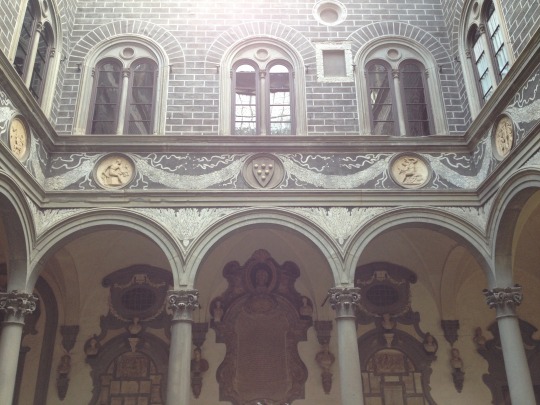
Friday brought an early morning with the class meeting at San Lorenzo at 8:30. By this time, I had a pretty good (though not great) idea of where everything was, so I had a leisurely walk to the basilica. Unfortunately, I got to the church earlier than the rest of my class, which meant a few minutes of walking around trying to spot anyone I recognized. Thankfully, I found them after a while at the back. Luckily, my favorite classmate was also running late, so at least I wasn’t the last to show up.

Once all gathered, we headed to the Old Sacristy. At the time of our trip, San Lorenzo did not permit pictures inside, so the photos here are a mix of Wikipedia and WGA.
Brunelleschi’s Old Sacristy. Look at those lovely arches and Corinthian capitals. In their architectural designs, both Brunelleschi and Michelangelo used this gray stone, pietra serena, which was native to Florence.
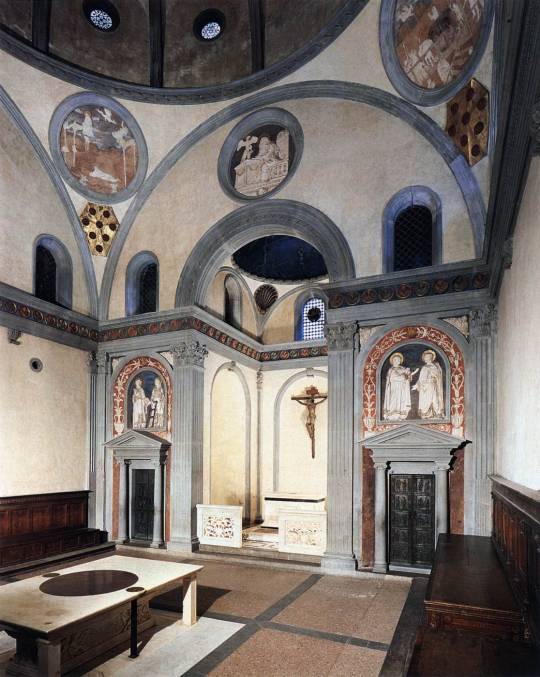
Michelangelo’s New Sacristy, commissioned by Leo X and Giulio de’Medici. Michelangelo designed it and completed some of the sculptures, including the famous Night, but he was never able to finish it.
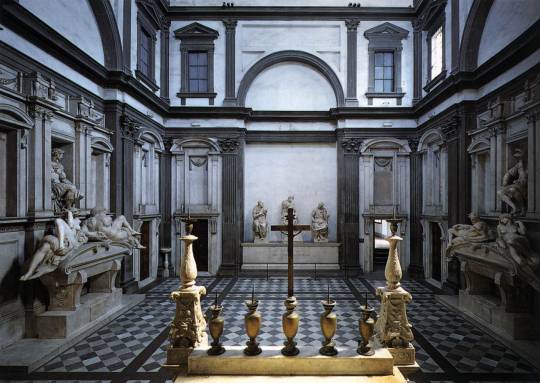
Night and Day flanking a sculpture of Giuliano de’Medici. Much has been made of Night’s pose and her physiognomy, ranging from the humorous “Michelangelo wasn’t comfortable with women so he stuck two oranges on a man’s chest,” to doctors speculating that Night shows symptoms of breast cancer to analysis of androgyny and late-Renaissance/early Mannerist concepts of beauty. Personally, I come down on the side that Michelangelo designed a figure that was both elegant and off-putting that reflects both the changes in art and the uncertainty in Italian culture during the beginning of the Mannerist period.
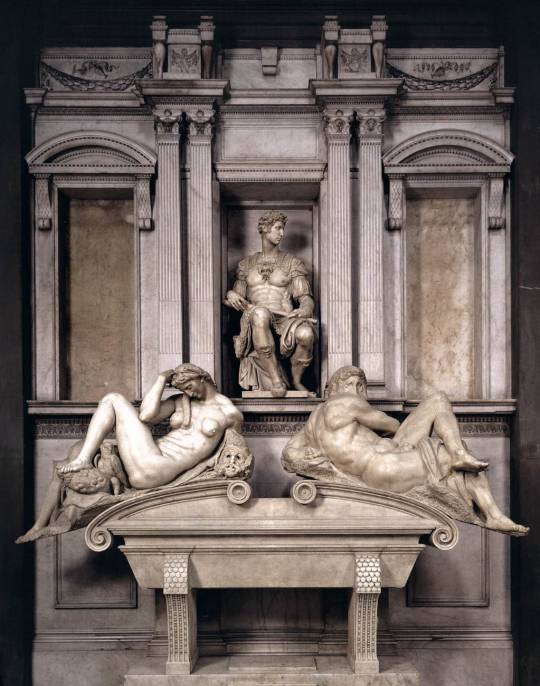
Dawn and Dusk with Lorenzo de’Medici. This is not a sculpture allegorizing Michelangelo’s beloved mentor but one of the lesser known Medicis, Lorenzo di Piero, Duke of Urbino, who’s probably more famous for his children, Catherine de’Medici and Allessandro, who became the first duke of Florence. Lorenzo the Magnificent’s tomb was never completed, but he is buried here with his brother Guiliano in a simple tomb underneath a Madonna and Child sculpted by Michelangelo.

From there we went to the Cappelli dei Principi (Chapel of the Princes). If you look at an aerial view of San Lorenzo, the large, octagonal dome between the two sacristies easily stands out. Of the sites we saw at San Lorenzo, this one with its height, opulence, and the mixture of dark stone was one of the most memorable for me. First photo from MuseumsinFlorence.com
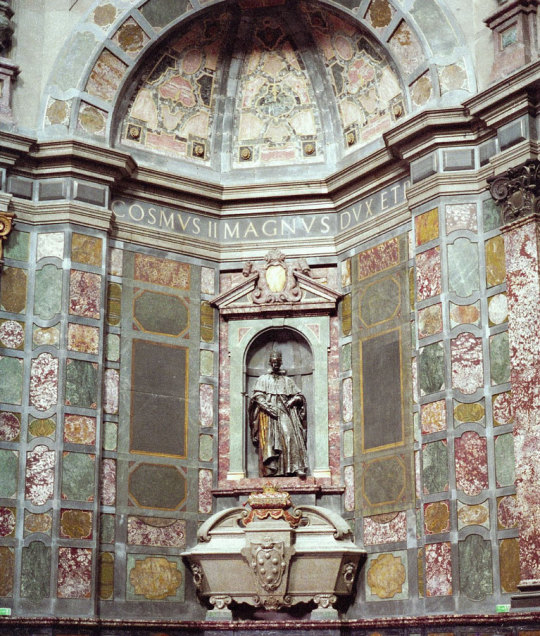

Peak Baroque aesthetic right here. This picture helps give some sense of how TALL this space is.
Off to the Laurentian Library!

Brunelleschi’s cloisters
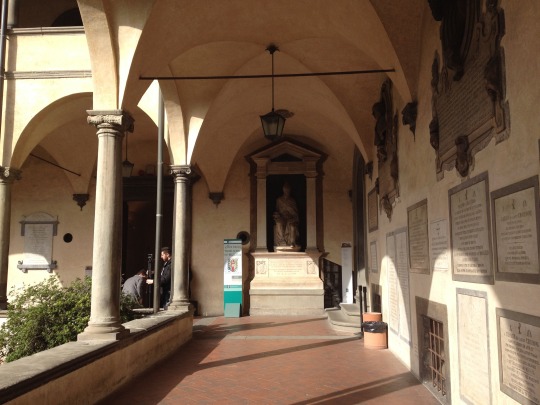
Orange trees!
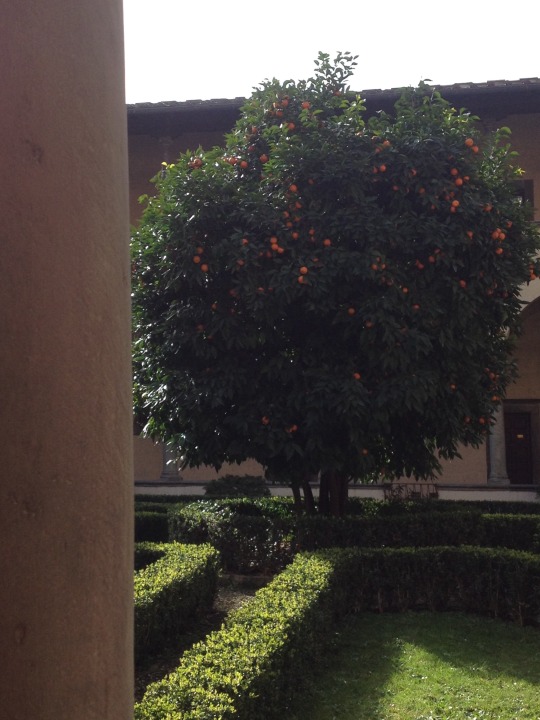
Inside, the vestibule with the famous steps designed by Michelangelo. Originally, Michelangelo wanted these stairs, which may be the first freestanding staircase in Western architecture, to be made of walnut but ended up using that gray stone seen in the Old and New Sacristy.

Subverting the rules of Classical architecture to make a characteristically Mannerist space
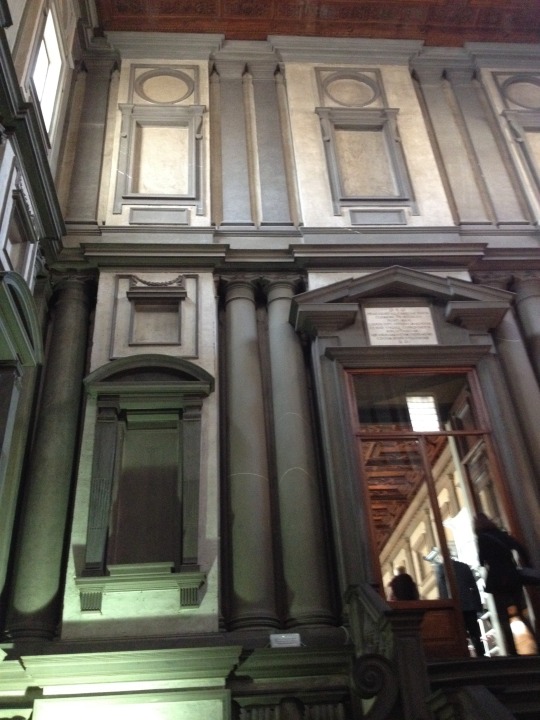
I love how the center aisle of the staircase seems to pool out into the vestibule.
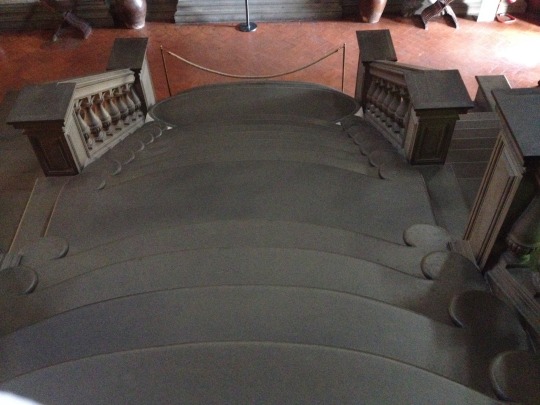
Inside the library, the floor with some great grotesques
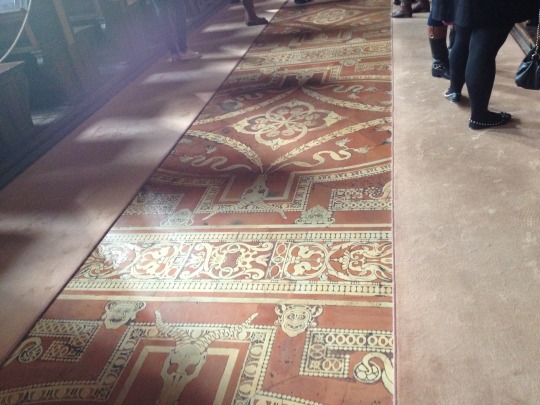
One of the reading stalls
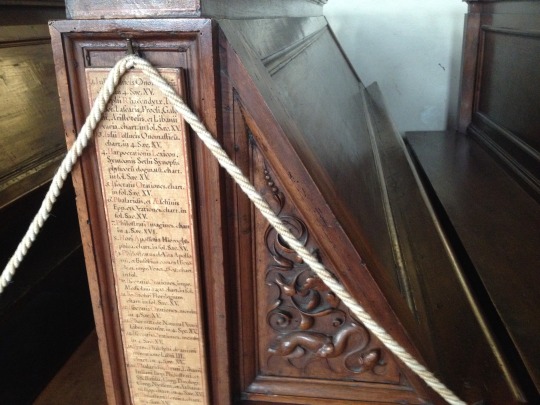
From there to the Medici Riccardi Palace. We primarily focused on the Chapel of the Magi, the tapestry room, and the Luca Giordano hall.
The Chapel of the Magi is actually quite small, smaller than you might think just looking at pictures of Benozzo Gozzoli’s frescoes online. It’s a very intimate space (confining if you’re in there with fifteen other people). The frescoes completely envelope you, and your eye follows the journey of the Magi along the walls. No pictures inside the Chapel, so pics are from travelsintuscany.com and wiki.
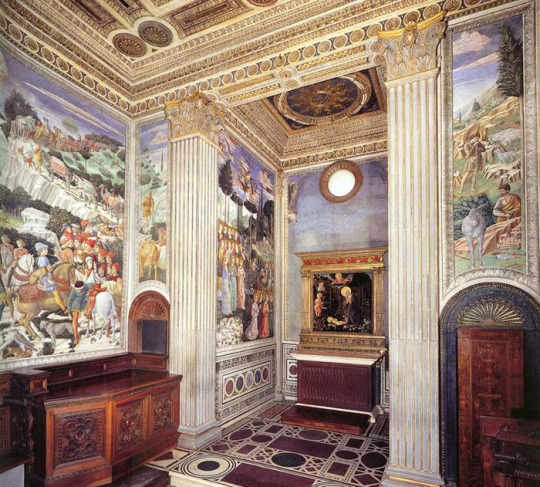
Like many Renaissance depictions of the Magi, Gozzoli included portraits of the Medici family among the Magi.
For a long time, there was speculation that the young king was a portrait of Lorenzo de’Medici, but recently, he’s been identified as one of the other members of the party (fourth figure from the left).

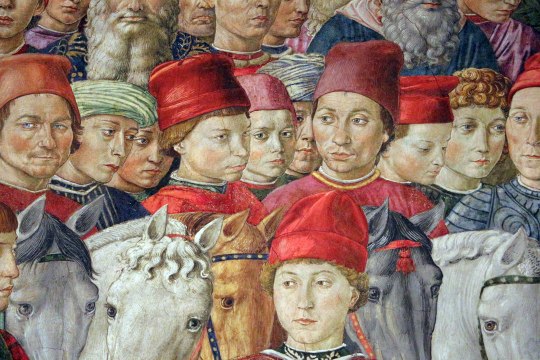
He does look a lot more like the later portraits we have of Lorenzo.
The Tapestry Room


This was interesting to see. It’s a Madonna and Child by Filippo Lippi, but on the other side is a drawing of a young man.
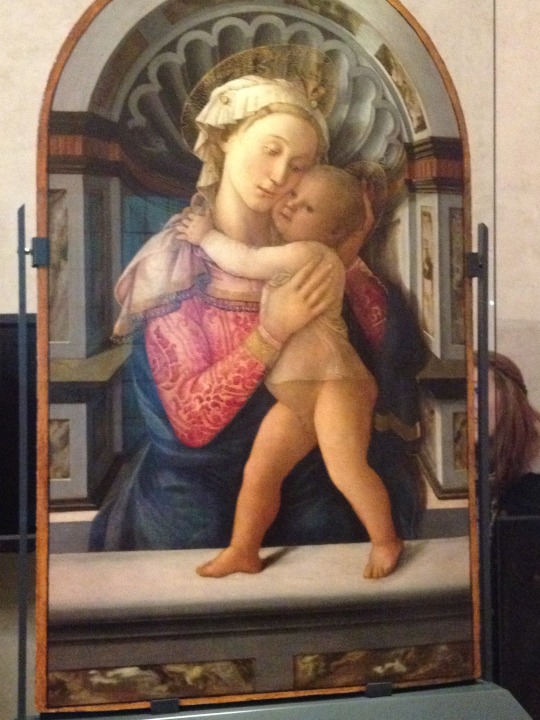

The Gallery, which is where Florence’s government meets.
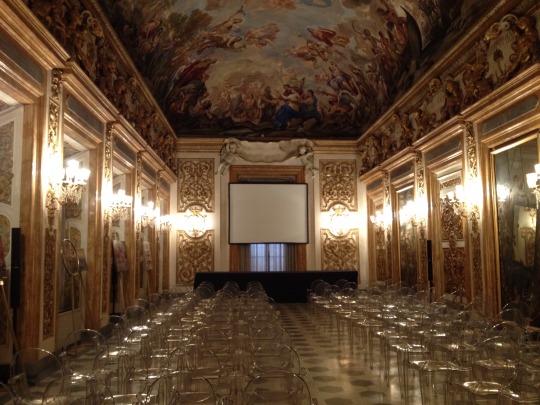
Giordano’s ceiling fresco, representing the creation of Man and the triumph of the Medici on Mount Olympus.
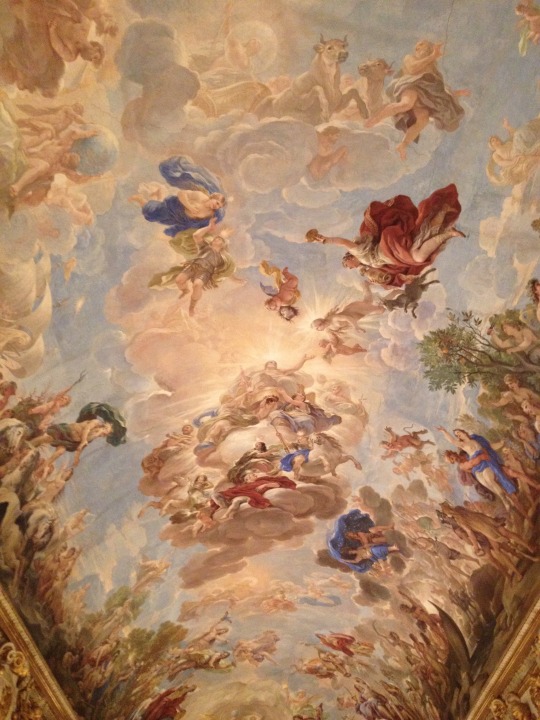
The courtyard with the sculpture of Orpheus.
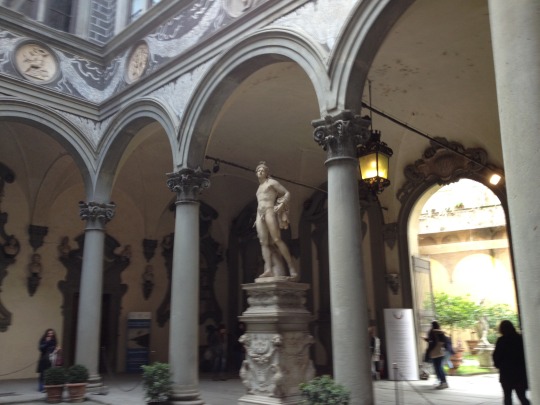
The gardens. In Hannibal, this was where “Dr. Fell” ran into Anthony Dimmond (thirsty scarf dad).
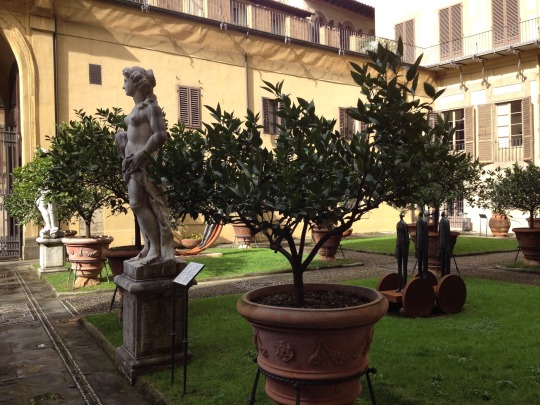
Once we were through with the area surrounding San Lorenzo, we split into two groups. My professor took half the class to the Florence Archives while my group headed to Santa Croce.
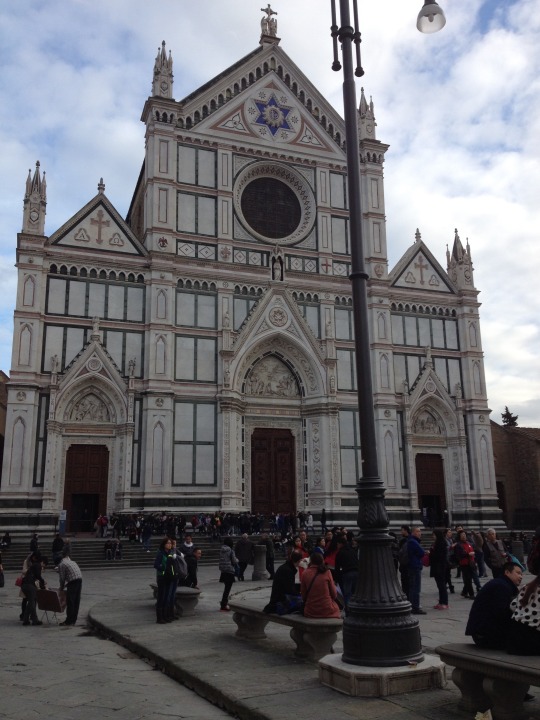
“The Church of Santa Croce, seat of the Franciscans, its vast interior ringing with eight languages as the hordes of tourists shuffle through, following the bright umbrellas of their guides, fumbling for two-hundred-lire pieces in the gloom so they can pay to light, for a precious moment in their lives, the great frescoes in the chapel.”


Of course, I had to check out all the tombs
Machiavelli’s tomb
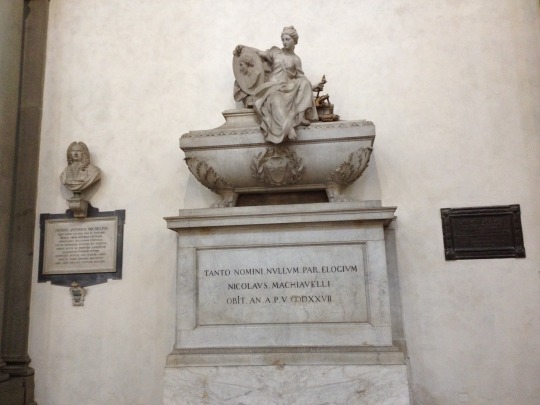
Dante’s memorial

Galileo’s tomb. All that Baroque covering up those frescoes *sigh*
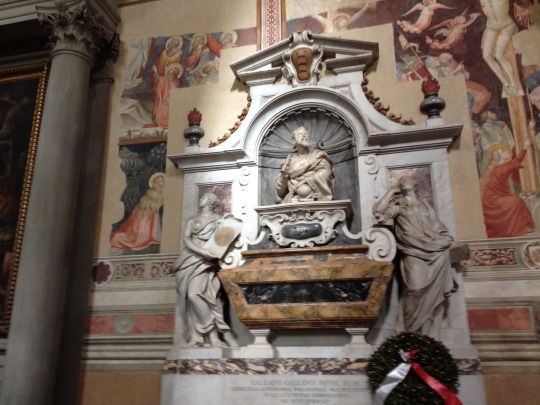
Michelangelo’s tomb. Definitely not what he had in mind, but Vasari went all out to honor his friend. Hopefully, Michelangelo does not mind too much that I write stories of questionable quality about his relationships with Leonardo and Raphael.
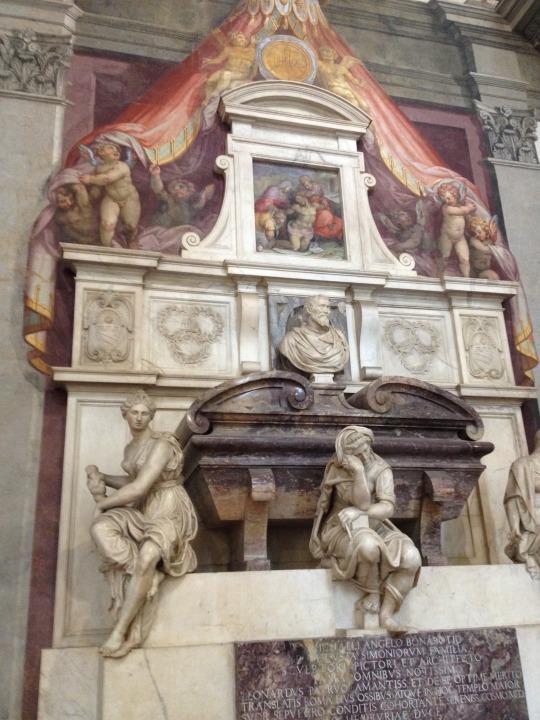
The altar
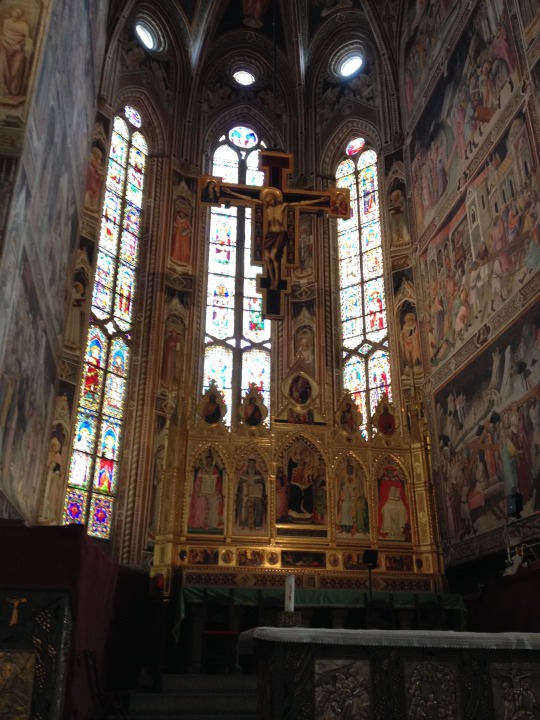
Bardi Chapel with one of the earliest depictions of St. Francis (sorry about the glare)
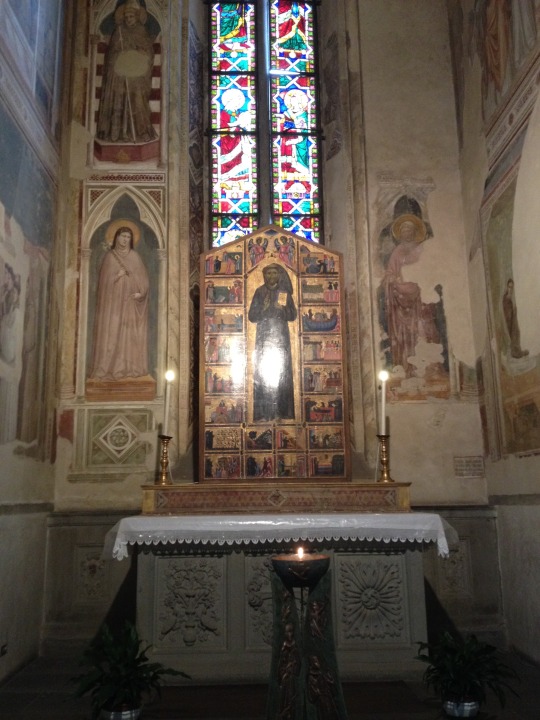
Death of St. Francis by Giotto and his followers
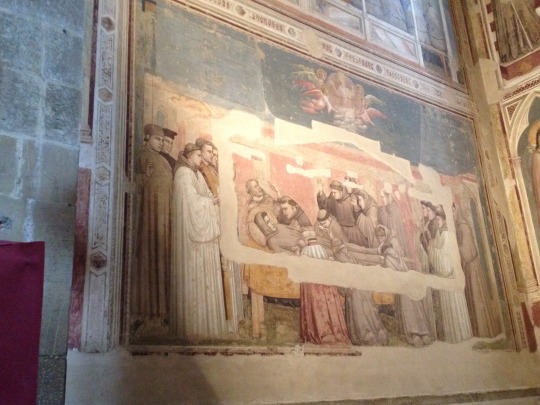
Just wanted a picture of the stained glass light on the stone floor

Baroncelli Chapel, Taddeo Gaddi’s fresco of David and Goliath

Because of the time, we didn’t have a chance to check out the Pazzi Chapel. I also did not take a close look at the Rinuccini Chapel (mostly because I didn’t know how relevant it would be to my research later—add that to the to-do list).
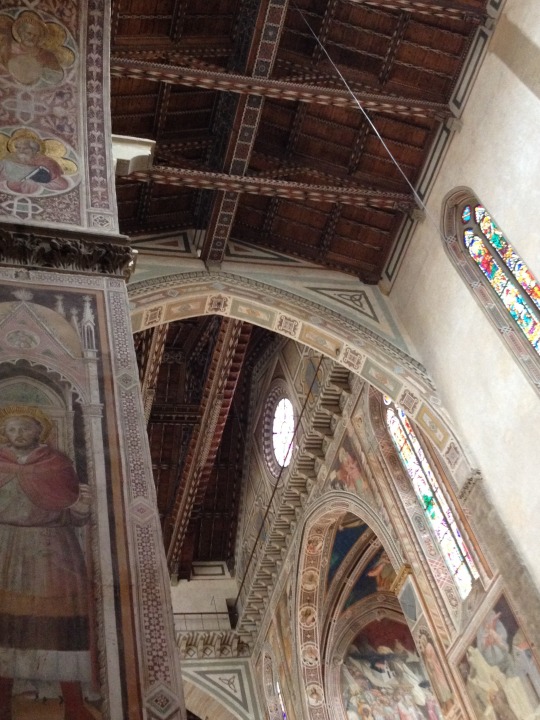
It was close to lunchtime, so we grabbed a sandwich nearby (tomato and mozzarella with an Orangina) and had some gelato under Dante’s imposing stare.
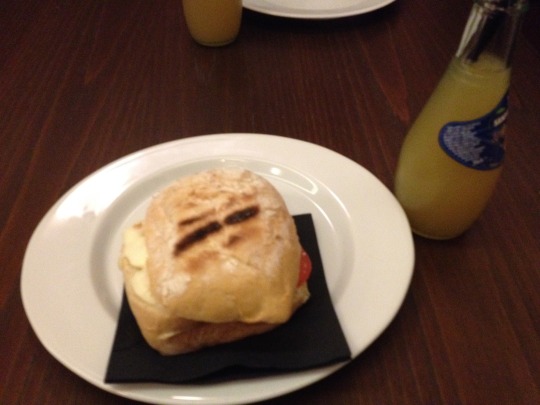

The façade of Santa Croce, completed in the 19th century.

Then it was off to the Florence Archives to briefly talk to the people who run the Medici Archive Project. I’ll be seeing them again in June for their paleography seminar. Once done at the Archives, we checked out the Duomo.
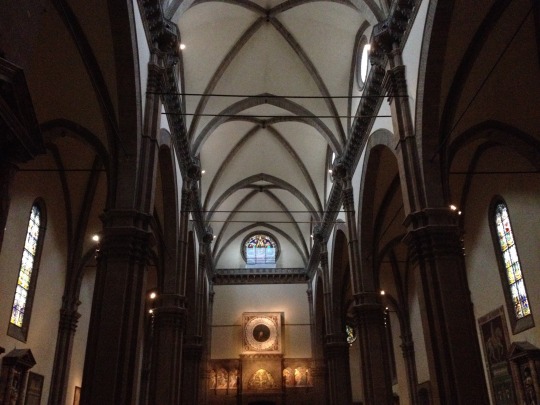
Vasari’s frescoes inside Brunelleschi’s dome. He’s showing up a lot in this write-up too, but Vasari has cast a long shadow over art history.
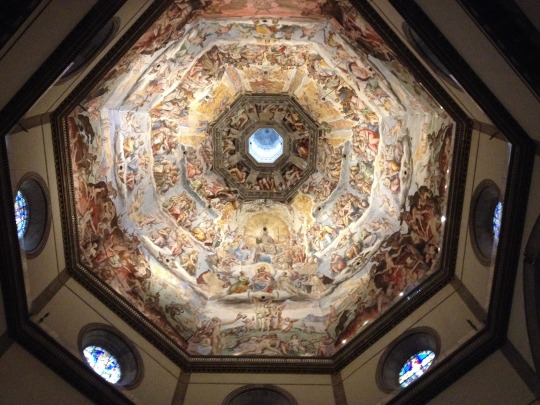
We then dispersed for a couple hours until meeting against for a farewell dinner that evening. I hate that I never caught the name of the restaurant (we met together at the cathedral and then walked over together) because the pasta carbonara and tiramisu I had was really good.
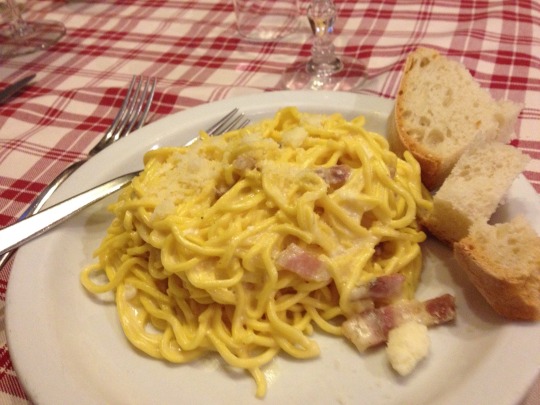
And that was it for the official class business! All in all, I learned a lot. However, I still had a day left to explore Florence on my own, which I will recount later (but not too much later).
3 notes
·
View notes